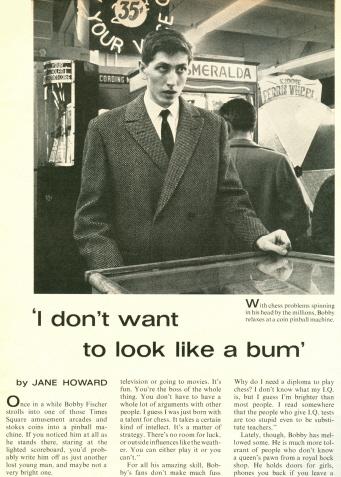
When contacting us by e-mail, correspondents are asked to include their name and full postal address and, when providing information, to quote exact book and magazine sources. The word ‘chess’ needs to appear in the subject-line or in the message itself.
| First column | << previous | Archives [39] | next >> | Current column |

An article about Bobby Fischer on pages 97, 98 and 100 of Life,
21 February 1964 contains a number of colourful observations
ascribed to the young master, but is it known that they are
‘safe’? As so often, we hesitate to quote from such an article,
bearing in mind Fischer’s remark ‘A lot of these quotes about me
are not correct’ (see Instant
Fischer).
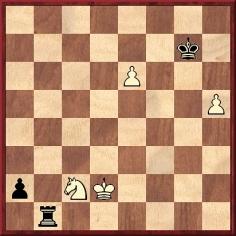
White to move.
This position was given in C.N. 1658. Play is said to have continued 44 h6+ Kxh6 45 e7 Rb8 46 Kc1 Kg7 47 e8(Q) Rxe8 48 Kb2 Re2 49 Ka1 Drawn. Our source was L. Verkhovsky’s book on drawn games; see page 27 of Nichya! (Moscow, 1972) or page 39 of the Spanish translation Tablas (Barcelona, 1973). The heading in each case was ‘Teichman v Marbl, Leipzig, 1913’, and we have cautiously refrained from assuming that White was Richard Teichmann and, particularly, that Black was the American problemist Murray Marble (1885-1919).
Now, Christian Sánchez (Rosario, Argentina) mentions that the position was given on pages 236-237 of How to Play Chess Endings by E. Znosko-Borovsky (London, 1940), the caption being ‘Teichmann v N., Berlin, 1913’.
Was White indeed Richard Teichmann, and how did the name ‘Marbl’ become involved?
Harrie Grondijs (Rijswijk, the Netherlands) draws attention to an illustration opposite page 288 of the May 1935 issue of El Ajedrez Español:
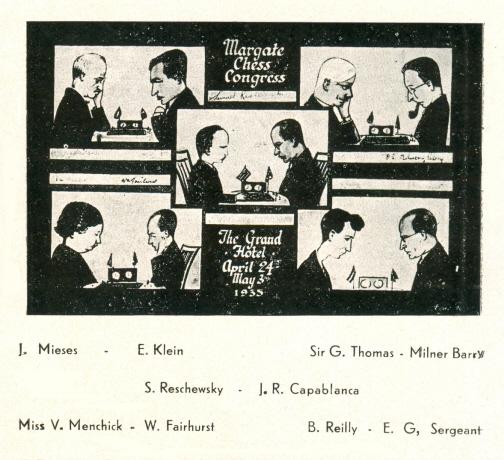
The mention of Ernst Klein (1910-90) prompts us to pose a quiz question: what connection did he have with a match for the world chess championship?
Klein appears on the far right of this group photograph, reproduced from page 2 of Staunton Centenary Tournament 1951 by H. Golombek (published in London later that year).
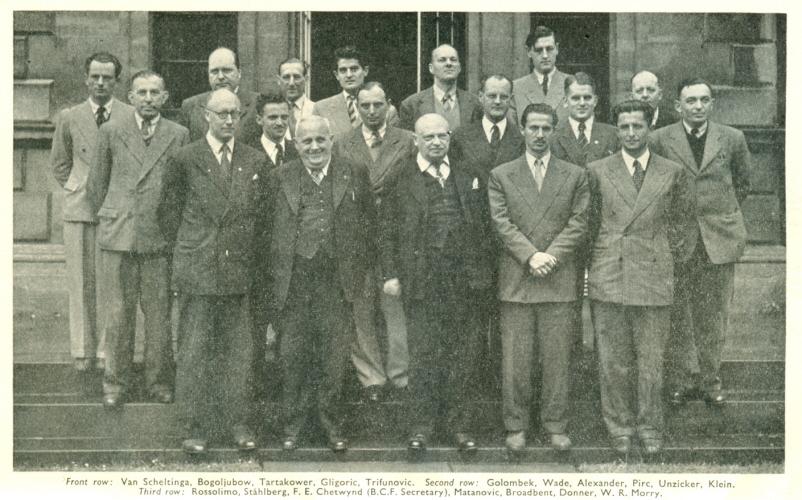
We hope to add in our feature article on Lord Dunsany a comprehensive list of his chess poems. Below is a little-known one, from page 214 of the July 1951 BCM:
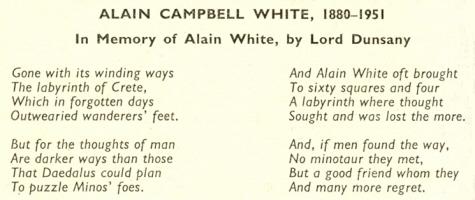
As mentioned in C.N. 4053, on page 113 of the April 1885 International Chess Magazine Steinitz wrote:
‘... the fearful misfortune which ultimately befell “the pride and sorrow of chess”, as Sheriff Spens justly calls Morphy, can only evoke the warmest sympathy in every human breast.’
It is still proving impossible to ascertain the source of that epithet. On page 308 of his Morphy book David Lawson wrote:
‘Sheriff Walter C. Spens, chess editor of the Glasgow Weekly Herald, quoted an announcement about it [a premature report of Morphy’s death] in his chess column of 25 November 1882, and added a five-stanza sonnet. It is owing to Sheriff Spens that we have “The Pride and Sorrow of Chess”.’
In fact, that edition of the newspaper (page 7) had a tribute to Morphy by Spens which was a single 14-line poem. Moreover, contrary to what might be inferred from Lawson’s words, no phrase such as ‘the pride and sorrow of chess’ appeared there.
It was in the 19 July 1884 issue of the Glasgow Weekly Herald (page 7) that Spens’ five-stanza tribute to Morphy appeared. (Lawson noted this on page 310 of his book, quoting the second stanza.) Again, though, the epithet is absent. In an endnote, Spens mentioned that his poem was adapted from previously-published material: not only the above-mentioned stanza in the 1882 Herald but also a composition ‘written about ten years ago at the time of a report as to Morphy’s insanity’ which had appeared, Spens said, in the Chess Player’s Chronicle.
We have yet to find any such poem in that periodical. However, Lawson’s book (page 409) stated that a poem by Spens about Morphy was included in the Huddersfield College Magazine at around the time in question, i.e. in the September 1875 issue. Does a reader have that text to hand?
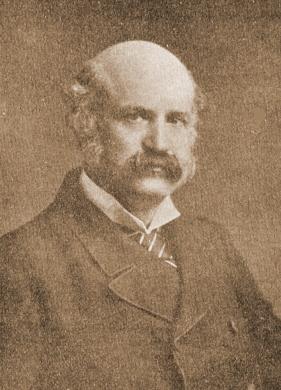
Walter Cook Spens
Although we are focusing here on Spens’ poems, it is quite possible that ‘the pride and sorrow of chess’ appeared in his prose. Nor should it be forgotten that, as reported in C.N. 4403, Golombek stated that the phrase was coined by D.W. Fiske.
Still on the subject of the Glasgow Weekly Herald, from page 7 of the 10 February 1883 edition we reproduce David Forsyth’s original proposal of the notation named after him:
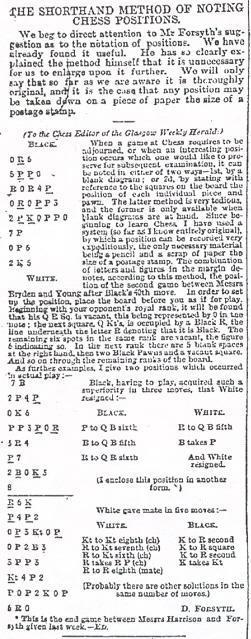
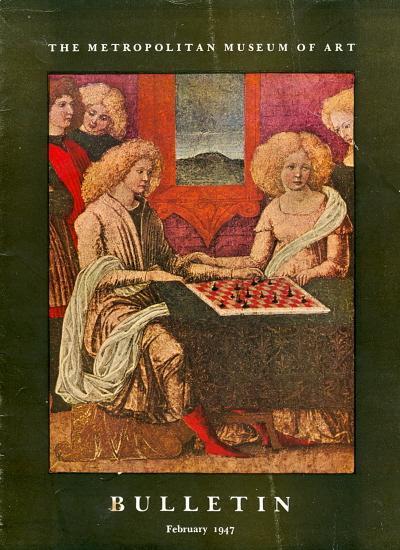
Pages 153-156 of the February 1947 Bulletin of the Metropolitan Museum of Art featured an article entitled ‘The Chess Players by Francesco di Giorgio’, and readers are left to decide how fanciful the writer, Harry B. Wehle, was in his description on pages 153-154:
‘Evidently the young man has already won, for his left hand holds one of the black chessmen and none of his adversary’s pieces remain on the board. The youths in the audience appear well pleased with the outcome of the game, whereas the maidens betray distress. The players themselves are moved by emotions of far more complicated sorts – and here Francesco di Giorgio proves himself a master of facial expression. Instead of feeling frankly triumphant as one would have anticipated, our hero has fallen into a state of discomfited indecision. For the lovely defeated heroine the game is already a forgotten episode, and as she gazes into space with sweetly solemn eyes she rests her right hand tenderly upon the arm of her recent opponent. Can it be, one asks oneself, that the poor creature has become infatuated with her vis-à-vis?’
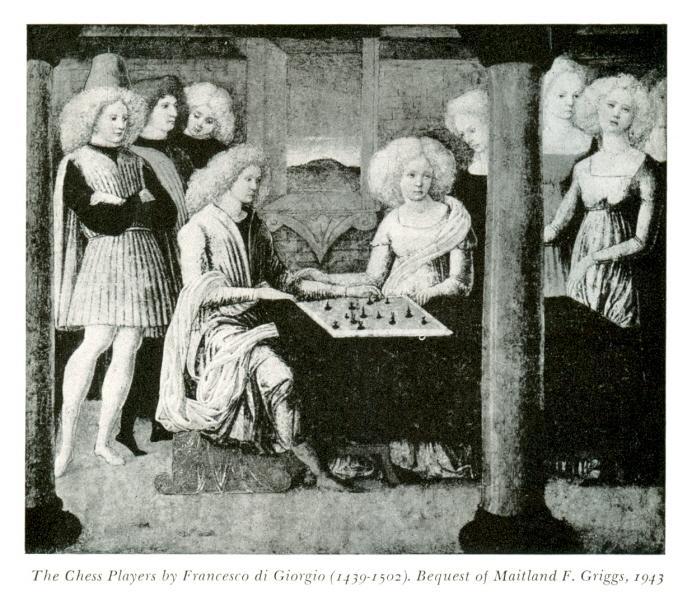
From page 155 of the February 1947 Bulletin
The board position and the board are certainly intriguing:
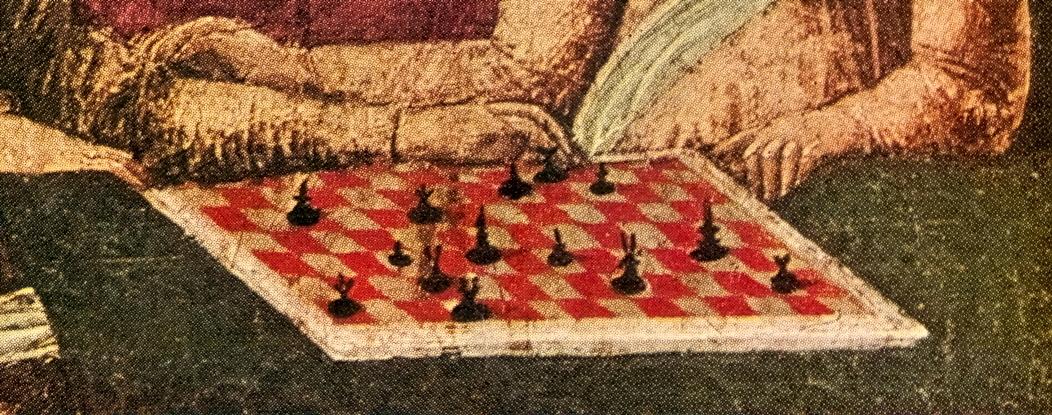
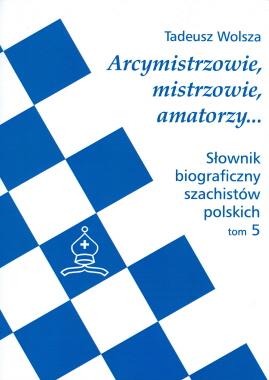
Tadeusz Wolsza has produced volume five of Arcymistrzowie, mistrzowie, amatorzy... (Warsaw, 2007), and we note in particular the section on Hersz (or Gersz) Rotlewi (1889-1920) on pages 101-108.
At Carlsbad, 1911 Rotlewi came fourth out of 26, defeating such players as Schlechter, Marshall, Nimzowitsch, Tartakower and Spielmann, and Tomasz Lissowski (Warsaw) wonders whether he is unique among twentieth-century masters for the lack of biographical information available. His exact birth and death dates are unknown, and Wolsza’s book reports that nothing is known about him until he appeared on the chess scene in 1905. Łódź was his place of birth and of death, and page 106 states that he contracted tuberculosis.
The photograph below shows Rotlewi (right) in play against B. Maliutin and is taken from page 278 of the Russian edition of the St Petersburg, 1909 tournament book.
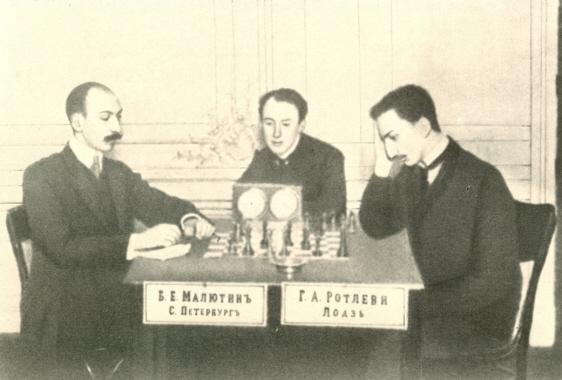
Brian Karen (Levittown, NY, USA) draws attention to an article ‘The Days and Knights of Tom Murphy’ by Wells Tower on page W08 of the Washington Post of 30 September 2007 and, in particular, the subsequent rectification from the newspaper:
‘The article incorrectly said that chess is the world’s oldest known board game. A board game found in the royal tombs at Ur in Iraq dating to about 2500 BC is believed to be the oldest, according to Melinda A. Zeder, curator of Old World archaeology at the Smithsonian Institution’s National Museum of Natural History.’
We note that already in A History of Board-Games Other Than Chess (Oxford, 1952) H.J.R. Murray stated that ‘men have played board-games for more than 4,000 years’, whereas page 12 reported:
‘The earliest known example of a gaming-board with accompanying pieces was exhibited in July 1909 at King’s College, London, by the Egyptian Exploration Fund, and is now in the Musée du Cinquantenaire, Brussels. It was discovered by officers of the Fund when excavating a predynastic cemetery at El-Mahasna, about eight miles to the north of Abydos in Upper Egypt. ...
The predynastic period in Egypt extended from about 4000 BC to 3500 BC, so this board may be a thousand years older than the next evidence of gaming-boards. In view of the surmise of the explorers that the grave might be that of a medicine man or magician, we cannot say for certain whether this board was used for a game or not. But it has definite affinities to later boards that have also been found in tombs.’
Olimpiu G. Urcan (Singapore) provides a report from page 14 of the Milwaukee Journal, 28 June 1896:
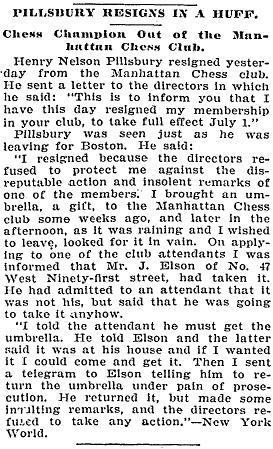
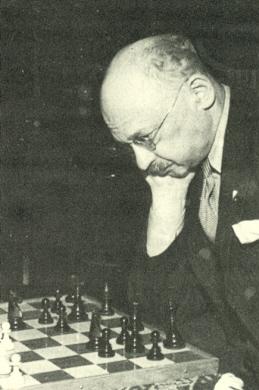
Savielly Tartakower
Below are all the games played by Tartakower under the pseudonym ‘G. Cartier’ that we have found in the BCM during the Second World War.
G. Cartier (Savielly Tartakower) – Harry Golombek1 d4 Nf6 2 Nf3 e6 3 Bg5 Be7 4 Nbd2 d5 5 e3 c5 6 c3 Nbd7 7 Bd3 b6 8 O-O Bb7 9 Qc2 h6 10 Bh4 O-O 11 Ne5 Nxe5 12 dxe5 Nd7 13 Bg3 f6 14 exf6 Bxf6 15 e4 Bh4 16 Rae1 Bxg3 17 hxg3 c4 18 Be2 Nc5 19 exd5 exd5 20 Nf3 Qf6 21 Nd4 Rae8 22 Bh5 Rxe1 23 Rxe1 Ne4 24 Bf3 a6 25 Re2 b5 26 Bxe4 dxe4 27 Qd2 Rd8 28 Qe3 b4 29 Rd2 a5 30 Qe2 Qf7 31 Qg4 Kh8 32 Kh2 Rd5 33 Kg1 Rd8 34 Qf4 Qxf4 35 gxf4 Kg8 36 Kf1 Kf7 37 g3 Kf6 38 Ke2 g5 39 fxg5+ hxg5 40 Ke3 Rd6
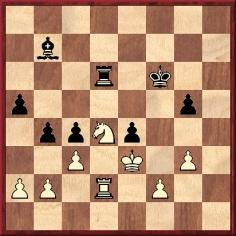
41 Nb3 cxb3 42 Rxd6+ Ke5 43 Rb6 bxa2 44 Rb5+ Resigns.
(Source: BCM, December 1941, page 306.) See C.N. 5140 for the magazine’s annotations.
The next game was played during a visit by Tartakower to ‘part of the Royal Netherland Brigade’.
Zak – G. Cartier (Savielly Tartakower)1 e4 Nf6 2 Nc3 e5 3 Bc4 d6 4 Nf3 Be7 5 d3 c6 6 a4 O-O 7 O-O Bg4 8 Bg5 h6 9 Bxf6 Bxf6 10 h3 Bd7 11 Nh2 Kh7 12 Qf3 Be6 13 Ng4 Bg5 14 Ne3 Nd7 15 Ne2 g6 16 g4 Qe7 17 Ng3 Nc5 18 Qe2 Bd7 19 b4 Ne6 20 Bxe6 Bxe6 21 c4 Rad8 22 Ng2 d5 23 c5 dxe4 24 Nxe4 Rd4 25 b5 Bd5
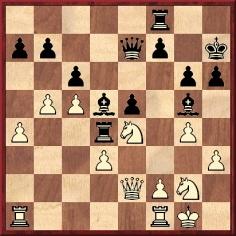
26 Nd6 b6 27 bxc6 bxc5 28 Nc4 Bxc6 29 Qxe5 Rxd3 30 Qxe7 Bxe7 31 Ne5 Bxg2 32 Kxg2 Rd5 33 Nc6 Bf6 34 Rad1 Bd4 35 Nxa7 f5 36 f3 Re8 37 Rfe1 Rde5 38 Rxe5 Rxe5 39 Rd2 Re1 40 Nc6 Bf6 41 a5 Ra1 42 Rd7+ Kg8 43 Ra7 Ra2+ 44 Kg3 c4 45 a6 c3 46 Nb4 f4+ 47 Kxf4 Ra4 and wins.
(Source: BCM, October 1942, pages 240-241.) There was a correction to the score from Tartakower on page 253 of the November 1942 issue, to the effect that the game in fact went ‘37...RxR 38 RxR B-B3’, but it is unclear to us how those moves fit into the game.
On the same visit the following game was played:
G. Cartier (Savielly Tartakower) – Zak and Traudmann1 e4 e5 2 Nc3 Nf6 3 Bc4 Nxe4 4 Qh5 Nd6 5 Bb3 Nc6 6 Nf3 g6 7 Qh3 e4 8 Ng1 Bg7 9 Nge2 O-O 10 O-O Ne8 11 Qe3 Nf6 12 Nxe4 d6 13 d4 Nxe4 14 Qxe4 Bf5 15 Qe3 Qd7 16 c3 Rae8 17 Qd2 Na5 18 Ng3 d5 19 Nxf5 Qxf5 20 Bc2 Qd7 21 b3 Re6 22 Bd3 Nc6 23 Kh1 Rfe8 24 f4 f5
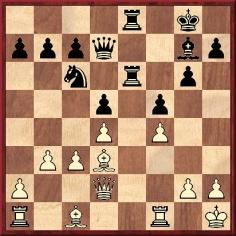
25 g4 fxg4 26 f5 Rf6 27 Qg5 Qf7 28 Ba3 Ne7 29 fxg6 Nxg6 30 Rxf6 Qxf6 31 Qxd5+ Kh8 32 Rf1 c6 33 Qh5 Qe6 34 Bc1 Rf8 35 Rxf8+ Bxf8 36 Kg2 Bd6 37 c4 Bf4 38 Bb2 Qe3 39 d5+ Kg8 40 Qxg4 Qxd3 41 Qe6+ Kf8 42 Qc8+ Ke7 43 Qxb7+ Ke8 44 Qc8+ Ke7 45 Qe6+ Kf8 46 Qf6+ Ke8 47 Qxc6+ Kf7 48 Qe6+ Kf8 49 Qf6+ Ke8 50 Qc6+ Kf7 Drawn.
(Source: BCM, October 1942, page 241.)
Julius du Mont and Zak – G. Cartier (Savielly Tartakower) and M. Chauvet1 e4 e5 2 Nc3 Nf6 3 Bc4 Nxe4 4 Qh5 Nd6 5 Bb3 Be7 6 d3 Nc6 7 Nge2 g6 8 Qf3 O-O 9 Bh6 Re8 10 Ne4 Nf5 11 Bxf7+ Kxf7 12 g4 d5 13 gxf5 Bxf5 14 O-O–O Kg8 15 Rhg1 Qd7 16 h4 Bxh4 17 Qh5 Be7 18 Rg2 Kh8
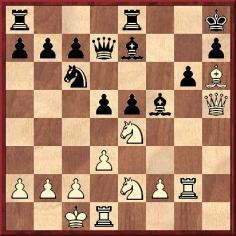
19 Ng5 Bxg5+ 20 Bxg5 Qf7 21 Qh4 Re6 22 Rh1 Rg8 23 Nc3 Ne7 24 Nb5 Nc8 25 Nxc7 Qxc7 26 Bf6+ Rxf6 27 Qxf6+ Qg7
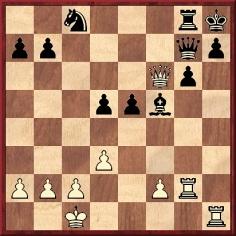
28 Rgh2 h5 29 Qxf5 Qh6+ 30 f4 gxf5 31 Rxh5 Qxh5 32 Rxh5+ Kg7 and wins.
(Source: BCM, December 1942, page 268.) There can be few games in which the loser made so many queen offers.
John Montgomerie – G. Cartier (Savielly Tartakower)1 d4 f5 2 g3 e6 3 Bg2 Nf6 4 Nd2 c5 5 c3 Nc6 6 e3 Be7 7 Ne2 O-O 8 O-O Qe8 9 e4 cxd4 10 cxd4 d5 11 exf5 exf5 12 Nf4 Qf7 13 Nf3 Ne4 14 Nd3 Bf6 15 Nde5 (Incorrectly given as ‘15 QKt-K5’.) 15...Qe7 16 Qb3 Rd8 17 Nxc6 bxc6 18 Bf4
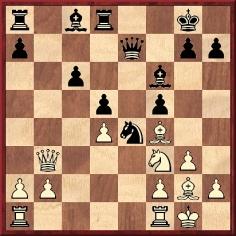
18...g5 19 Be3 g4 20 Ne1 Ba6 21 Nd3 Rab8 22 Qc2 Bxd3 23 Qxd3 Rxb2 24 f3 Nd6 25 fxg4 fxg4 26 Rae1 Qg7 27 Bc1 Bxd4+ 28 Kh1 Rf2 29 Rxf2 Bxf2 30 Rf1 Bb6 31 Rf4 Rf8 32 Rxf8+ Qxf8 33 Bf4 Qf5 34 Qe2 Ne4 35 White resigns.
(Source: BCM, December 1942, page 269.)
The next contest was described as ‘the second game from a private match’.
G. Cartier (Savielly Tartakower) – Zak1 d4 Nf6 2 Nf3 g6 3 g3 Bg7 4 Bg2 d5 5 c4 c6 6 O-O O-O 7 Nc3 Nbd7 8 cxd5 cxd5 9 Ne5 e6 10 f4 Nxe5 11 fxe5 Ne8 12 e4 dxe4 13 Nxe4 f5 14 exf6 Bxf6 15 Nxf6+ Rxf6 16 Rxf6 Qxf6 17 Bf4 Qe7 18 Qd2 Nd6 19 Re1 Nc4 20 Qc3 Nb6
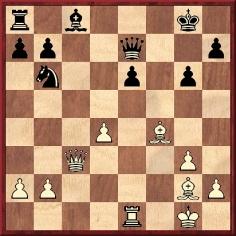
21 d5 Qf7 22 Bh6 e5 23 Rf1 Bf5 24 Qxe5 Re8 25 Qd4 Qd7 26 Qf6 Nc4 27 d6 Qf7 28 Bd5 Resigns.
(Source: BCM, March 1943, page 64.)
G. Cartier (Savielly Tartakower) – W.G. Sugden1 e4 Nf6 2 e5 Nd5 3 c4 Nb6 4 d4 d5 5 c5 N6d7 6 e6 fxe6 7 Bd3 Nf6 8 Nf3 g6 9 h4 Bg7 10 Ne5 Nbd7 11 Nf3 O-O 12 Ng5 Nb8 13 h5 Ne4 14 Nxh7 Nxf2
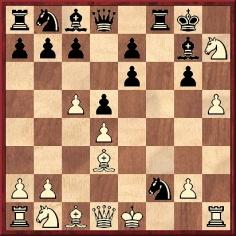
15 Nxf8 Nxd1 16 Nxg6 Bxd4 17 Kxd1 Nd7 18 h6 Nf6 19 Nc3 Bd7 20 Bg5 Kf7 21 h7 Kg7 22 h8(Q)+ Qxh8 23 Rxh8 Rxh8 24 Nxh8 Kxh8 25 Kd2 ‘and Black is a rook down’.
(Source: BCM, August 1943, page 173.)
G. Cartier (Savielly Tartakower) – Cunningham1 e4 e5 2 f4 exf4 3 Nf3 Be7 4 Bc4 Bh4+ 5 g3 fxg3 6 O-O gxh2+ 7 Kh1 Be7 8 Bxf7+ Kxf7 9 Ne5+ Ke8 10 Qh5+ g6 11 Nxg6 Nf6 12 Rxf6 Bxf6 13 Ne5+ Ke7 14 Qf7+ Kd6 15 Nc4+ Kc5 16 Qd5+ Kb4 17 a3+ Ka4 18 b3 mate.
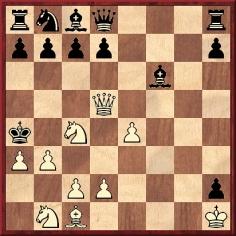
(Source: BCM, August 1943, page 174.)
G. Cartier (Savielly Tartakower) and P.H. Hazzard – J.C. Waterman and R.G. Gray1 e4 e5 2 Nf3 Nc6 3 Bc4 Nf6 4 Ng5 d5 5 exd5 Na5 6 d3 h6 7 Nf3 e4 8 Qe2 Nxc4 9 dxc4 Bc5 10 Nfd2 O-O 11 Nb3 Bg4 12 Qf1 Bd6 13 h3 Bh5 14 g4 Bg6 15 Be3 Re8 16 Nc3 Bb4 17 O-O–O Bxc3 18 bxc3 a5 19 Qe2 Nd7 20 h4 Ne5 21 Nd2 Qd6 22 Kb2 a4 23 Ka1 Qa6 24 Rhg1 Qa5 25 Bd4 Nf3 26 Nxf3 exf3 27 Qxf3 Bxc2
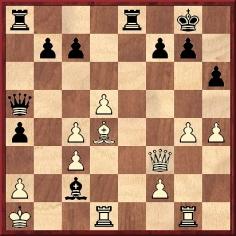
28 g5 Bxd1 29 Qxd1 Ra6 30 gxh6 Rg6 31 h5 Rxh6 32 Bxg7 Resigns.
(Source: BCM, May 1944, pages 102-105.)
G. Cartier (Savielly Tartakower) – Maurice Ellinger1 e4 c6 2 Nc3 d5 3 Nf3 dxe4 4 Nxe4 Bf5 5 Ng3 Bg6 6 h4 h6 7 Ne5 Bh7 8 Qh5 g6 9 Qf3 Qd5
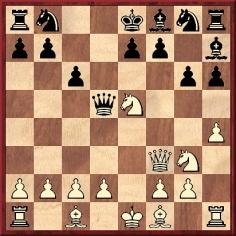
10 Qxd5 cxd5 11 Bb5+ Nc6 12 Nxc6 a6 13 Ba4 Resigns.
(Source: BCM, July 1944, page 155.)
T.J. Beach – G. Cartier (Savielly Tartakower)1 e4 c5 2 Nf3 Nf6 3 Nc3 d6 4 d4 cxd4 5 Nxd4 g6 6 f3 Bg7 7 Be3 O-O 8 Qd2 Nc6 9 O-O–O Bd7 10 g4 Rc8 11 Kb1 Ne5 12 h4 Nc4 13 Bxc4 Rxc4 14 h5
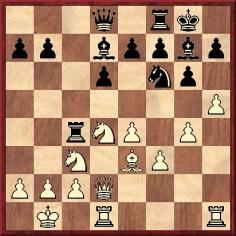
14...b5 15 hxg6 fxg6 16 Ndxb5 Bxb5 17 Nxb5 Qb8 18 Nd4 Rfc8 19 Rc1 d5 20 e5 Qxe5 21 c3 Qd6 22 g5 Nh5 23 f4 a5 24 f5 Bxd4 25 Bxd4 Ng3 26 fxg6 Qxg6+ 27 Ka1 Nxh1 28 Rxh1 R4c6 29 Qh2 Re6 30 a3 Rf8 31 Qg2 Qe4 32 Qh3 Rf3 33 Qh5 Qd3 34 White resigns.
(Source: BCM, March 1945, page 59.)
The final game is from a 27-board simultaneous exhibition:
G. Cartier (Savielly Tartakower) – J.T. Keable1 e4 Nc6 2 d4 d5 3 Nc3 e6 4 Nf3 Bb4 5 e5 Nge7 6 Bd3 Nf5 7 Bxf5 exf5 8 Qd3 Be6 9 O-O O-O 10 Ne2 Be7 11 c3 Nb8 12 Nf4 Nd7 13 Kh1 c5 14 Be3 c4 15 Qd2 Kh8 16 b3 Nb6 17 Nxe6 fxe6 18 Bg5
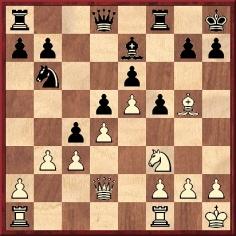
18...a5 19 Bxe7 Qxe7 20 Ng5 cxb3 21 axb3 a4 22 bxa4 Rxa4 23 Rxa4 Nxa4 24 f4 h6 25 Nf3 Rc8 26 Ra1 Nxc3 27 g3 Ne4 28 Qb2 Qf7 29 Ra7 Qh5 30 Kg2 Rc3 31 White resigns.
(Source: BCM, June 1945, page 139.)
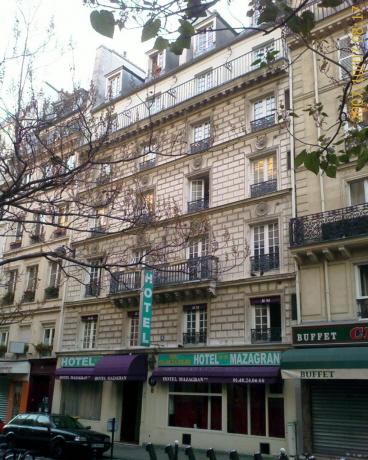
Hassan Roger Sadeghi (Lausanne, Switzerland) sends this photograph, taken on 7 October 2007, of the Hôtel Mazagran in Paris. As noted in our feature article Where Did They Live?, Tartakower was a resident there already in the 1920s, and it was also his address at the end of his life.
Below we add a letter written by Tartakower to John C. Owen (who sent us a copy many years ago) from Paris on 28 January 1956, i.e. about a week before the master died. He provided information about the strongest chess club in Paris and mentioned that his second Best Games volume would be appearing in the first half of 1956.
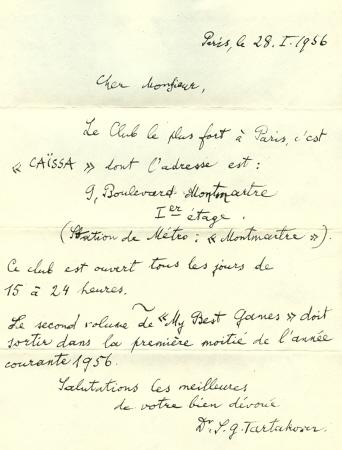
Hans-Georg Kleinhenz (Munich, Germany) points out that the game conclusion was given on page 335 of Die Schachwelt, 21 December 1912:
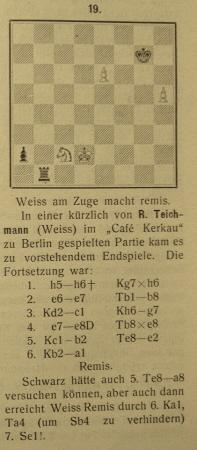
Our correspondent comments that since Richard Teichmann was a contributor to Die Schachwelt the item is likely to be based on first-hand information.
In C.N. 2571 (see Adams v Torre – A Sham?) a correspondent referred to the difficulty in determining Irving Chernev’s source for a 21-move game – a French Defence – between C. Torre and E.Z. Adams (New Orleans, 1920) presented on page 418 of his book 1000 Best Short Games of Chess (New York, 1955).
We now note that the game was given on pages 283-284 of the December 1942 BCM, introduced as follows:
‘Mr Reinfeld is sending us some bright old games from time to time which have not hitherto appeared in the BCM.’
Where Reinfeld obtained the game was not specified.
C.N. 5202 asked what connection Ernst Klein had with a match for the world chess championship.
In his column in The Times, 18 February 1978 (page 13) Harry Golombek wrote:
‘It looks as though the first world championship match in which there were seconds whose official duty it was to aid their principals in analysis during adjournments was the 1935 Alekhine-Euwe match in the Netherlands. Alekhine’s second was the Dutch master Landau, and Euwe had the Hungarian grandmaster Maróczy as his second.’
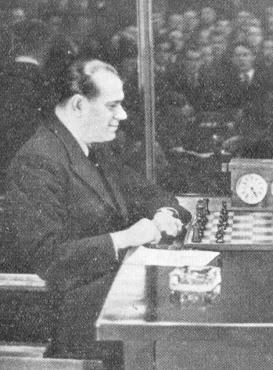
Salo Landau
However, in a letter to the newspaper published on 11 March 1978 (page 13) Ernst Klein wrote:
‘The facts are as follows: Landau helped Euwe and I helped Alekhine. Landau and myself were designated “trainers”.’
Golombek quoted those words in his column of 18 March 1978 (page 10) and commented:
‘Fortunately my library is pretty rich in journals and magazines for the period in question, and I also have no less than five books dealing solely with the match.
An examination of these works shows that there is no substance whatsoever for Mr Klein’s correction of my statement that Landau was Alekhine’s second and Maróczy Euwe’s.’
After quoting from various contemporary sources, Golombek concluded:
‘All this would seem to show that Mr Klein has got his recollections of this famous match in a most inglorious muddle. Possibly he did give Alekhine some unofficial help during the last few games of the match, but he never served in any official capacity at any time in the contest.’
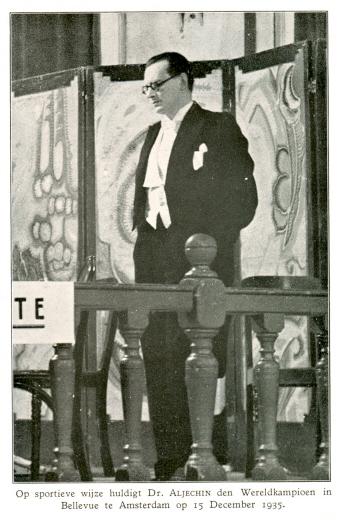
Golombek returned to the subject in his column of 8 April 1978 (page 12) after verifying the facts with Euwe, who informed him:
‘You are right: Maróczy was my second and Landau was Alekhine’s second during the 1935 WC Match. But after the 26th or the 27th game Landau withdrew after a disagreement with Alekhine. In the remaining games Mr Klein helped Alekhine, but he had no official status.’
Golombek evidently did not consult Max Euwe Biografie van een Wereldkampioen by Alexander Münninghoff, Max Euwe and Jules Welling (Amsterdam-Antwerp, 1976). Pages 184-185 discussed Klein’s brief, controversial involvement as Alekhine’s ‘trainer’. (See also pages 134-136 of the English edition, published in 2001.) What else is known about Klein and the 1935 world championship match, and particularly from contemporary sources?
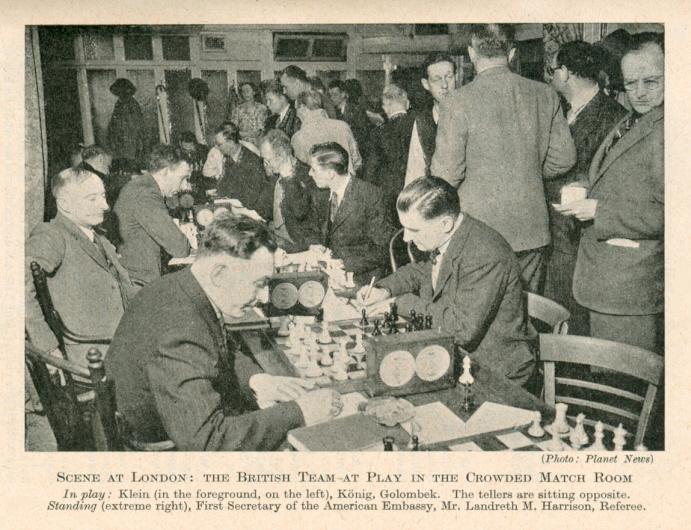
A photograph from The
Anglo-Soviet Radio Chess Match by E. Klein and W. Winter
We have been re-reading Golombek’s chess column in The Times, which contained much of interest. On 10 December 1977 (page 11), for instance, he discussed, none too warmly, Fred Reinfeld’s writing career, although he seems to have considerably overestimated the quantity of the American’s production: ‘My own library contains 62 books by him and I believe this to have been about one fifth of his output.’ Reinfeld’s books on Botvinnik, Tarrasch and Nimzowitsch were deemed unimpressive, and regarding Nimzovich the Hypermodern (Philadelphia, 1948) Golombek wrote:
‘... there appeared in the American Chess Review of the time a review couched in the most glowing terms that occupied the whole of the last page. No full signature appeared but simply the initials F.R., and your guess is as good as mine as to whether this meant that the review was by Fred Reinfeld.’
It is unclear what Golombek had in mind, but the extensive book review on page 184 of the June 1949 Chess Review was signed not ‘F.R.’ but ‘J.R.’ (John Rather, the magazine’s Managing Editor).
Although Golombek mentioned new chess literature relatively seldom, he usually practised plain speaking. Commenting in his column of 24 June 1978 (page 19) about Raymond Keene’s book on the 1977-78 Korchnoi v Spassky Candidates’ match, he wrote that the account ‘is so partial as to fail to carry any real conviction’. On 5 July 1975 (page 7) he observed:
‘... it is true that, like everybody else, I started off as a player and that when I won the London Boys’ Championship some 48 years ago I had not the faintest inkling that I would end up as that thing of silk, a mere chess journalist. ...
In the absence of such vates sacri as Breyer, Nimzowitsch, Réti and Tartakower we, who defend the bad against the worse, do our best to maintain a sort of semi-literacy in the world of chess. With certain shining exceptions our modern grandmasters lack the literary gifts of the four great players I have mentioned. All four were indeed genuine grandmasters both in playing chess and in writing about it.
Their books and writings will endure. I wonder how much of the flood of writing that we have nowadays will last.’
His columns naturally contain many reminiscences. On 29 October 1977 (page 11) he discussed F.J. Marshall:
‘I met him towards the end of his career when I was a young master and he was long past his most distinguished best. ... There was a genuine quality about him that, in combination with his enthusiasm and zest for chess, rendered him enormously sympathetic.
He was one of the few great players (Keres was perhaps the only other one) of whom no-one ever said anything to their detriment.’
Golombek was not always sure of his own playing record. On 8 November 1975 (page 11) he wrote:
‘I well remember the late Hugh Alexander asking me many years ago what were my results in my games against Sir George Thomas. I replied I was not sure but believed I was one or two up. Whereupon he laughed and said that was exactly the reply Sir George had given him when asked what his results were with Golombek.’
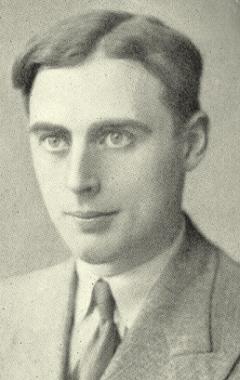
C.H.O’D. Alexander
His column on 16 July 1977 (page 10) praised Alexander highly, noting that at Hastings, 1937-38 he had finished equal second with Keres, below Reshevsky but above Fine and Flohr:
‘Had events pursued their normal course I am now convinced that Alexander would have got very near the world title. The quality of his chess was rising all the time, and his knowledge of the technical part of the game continually deepening.
But then came the Second World War.’
On 2 July 1977 (page 9) Golombek referred to the 1935 Olympiad in Warsaw and his country’s match against Estonia:
‘I beat Ilmar Raud on fourth board, being rather surprised when, as I was about to give checkmate, my opponent took hold of my queen and made the mating move himself.
... To all those of us who took part in the Warsaw Olympiad and saw Keres play it was apparent that a new genius had arrived and one that was going to become a world force. ... I remember, since I was not playing in the 18th round, watching him beat Ståhlberg in the match Estonia-Sweden. After the game Ståhlberg was moving the pieces about the board in an attitude of disbelief and uncomprehension, and I asked him about the game. “He won”, said Ståhlberg. “He shouldn’t have done, but I don’t know quite why.”’
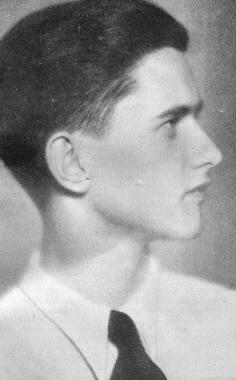
Paul Keres
On 17 November 1973 (page 9) he related his experience at London, 1946:
‘This was an event comprising two international tournaments of approximately equal strength and remains vividly in my recollection as a period of intense cold when, owing to lack of heating, the temperature in the playing hall resembled that of Moscow on a dark winter night. I played in my overcoat and had big motoring gloves on so that when I had to make a move I lost some time taking a glove off.’
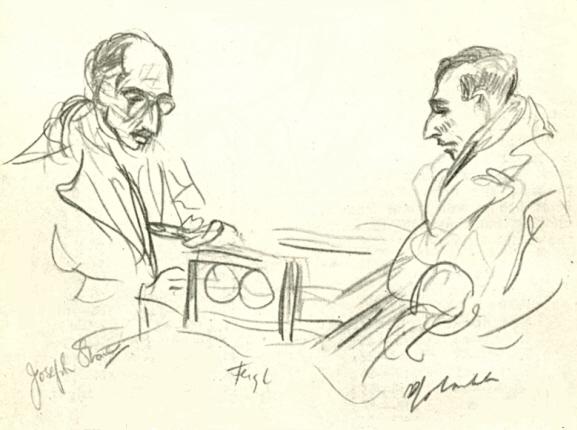
J. Stone and H. Golombek, from
the London, 1946 tournament book
From the 20 August 1977 (page 9) column:
‘Looking back through the 50 odd years from the point when in my middle teens I first became aware there existed something like world championship chess right down to the present day, I would say that in my lifetime there have been five world champions who were and are great match-players as well as great tournament-players: These are, in chronological order, Lasker, Capablanca, Alekhine, Botvinnik and Fischer.
Lasker and Capablanca were intuitively great match-players. They were blessed with the art of match-play in their bones at birth. But the other three, Alekhine, Botvinnik and Fischer, had to work hard to achieve the same heights as their intuitive predecessors. Not that this in any way reflects against them in their capacity both as great players and the creators of great masterpieces. A good book with a wonderful collection of games could be made out of a study of the match games of these three. Maybe I will attempt it if and when I finish the half a dozen books on which I am engaged at the moment.’
As regards that last remark, it seems to us that in the remainder of his life Golombek brought out only two books: his Encyclopedia and Beginning Chess.
He enjoyed making lists, and on 14 May 1977 (page 9) he gave an unusual selection of the ‘ten most interesting personages’ from the past 100 years:
‘I think they would be, in roughly chronological order, Zukertort, Charousek, Rubinstein, Nimzowitsch, Alekhine, Breyer, Tartakower, Bronstein, Tal and Larsen. Reserves could be Carlos Torre, Winawer, Pillsbury and Marshall and a half a dozen other American masters such as Dake, the proud friend of Al Capone, and William [sic] Weaver Adams, author of White to play and win and a sodium bicarbonate addict.’
His column of 27 May 1978 (page 9) discussed Irving Chernev’s book The Golden Dozen (Oxford, 1976) concerning the 12 greatest players of all time. Noting that Morphy, Steinitz and Tarrasch were ‘strange omissions’, Golombek considered that the criteria should concern ‘not only prowess as a player but also what these great players have achieved and, most important, what contributions they have made to the knowledge and theory of chess’. Taking those factors into account, he offered as his top six, ‘in chronological order’, Morphy, Steinitz, Lasker, Capablanca, Alekhine and Botvinnik, and observed:
‘Perhaps (and here it is necessary in the interests of brevity to overdo the comparatives and superlatives) one might say that Morphy was the greatest player of the game, Steinitz the greatest innovator, Lasker the greatest practical player, Capablanca the greatest natural genius, Alekhine the most perfect player and Botvinnik at his best (and this best lasted quite a time), the most magnificent player the world has yet seen.’
Rather oddly, Golombek then added:
‘Nor am I by any means convinced that this is really and absolutely the top six. There are a dozen more, any one of whom could be among the leading six: Anderssen, Chigorin, Tarrasch, Rubinstein, Keres, Smyslov, Bronstein, Boleslavsky, Tal, Spassky, Fischer and Karpov.’
The idea of Boleslavsky being among the half-dozen greatest players of all time is certainly challenging.
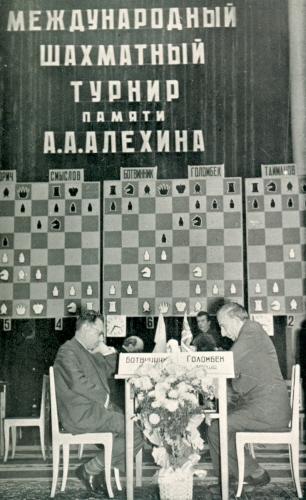
M. Botvinnik and H. Golombek, Alekhine Memorial, Moscow, 1956
Later in the same article Golombek wrote:
‘You will have noticed I have omitted Nimzowitsch from my lists, and this is because I have reserved him for a special list of the great eccentrics – to which list also belong such colourful figures as Breyer, Larsen and Simagin.’
Although Golombek was by no means averse to praising Nimzowitsch as a player and writer, his column on 17 September 1977 (page 10) expressed a less admiring view:
‘Colourful and energetic though his writings were, they are based on a fallacy. He gives you a collection of tactics which he elevates into a so-called system. His zestful writing and his great combinational gifts have tended to mask this; but in truth he gives us a façade rather than a building with inner dimensions.’
John Townsend (Wokingham, England) has found in the 1851 census an entry at Hill Street for William Harris, described as a chemist and druggist aged 38 who was born in Shelton, Bedfordshire. Our correspondent has also traced at the same address a reference to William Edward Harris in the Surrey Post Office Directory of 1855.
A game-score often wrongly disseminated is ‘Blake v Hooke, London, 1891’: 1 e4 e5 2 Nf3 d6 3 Bc4 f5 4 d4 Nf6 5 Nc3 exd4 6 Qxd4 Bd7 7 Ng5 Nc6 8 Bf7+ Ke7 9 Qxf6+ Kxf6 10 Nd5+ Ke5 11 Nf3+ Kxe4 12 Nc3 mate.
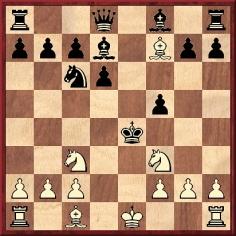
The game continues to be handled carelessly even by writers who are aware that it was long ago shown to be spurious. For instance, on pages 90-91 of Chess Lists (Jefferson, 2002) A. Soltis wrote:
‘This version [i.e. ending with 12 Nc3 mate] appeared, for example, in Chess Sparks [by J.H. Ellis], published in 1895. [Ellis’ book merely stated after 7...Nc6 ‘and White gives mate in five moves’.] It was repeated in Julius du Mont’s 200 Miniatures [200 Miniature Games of Chess] but with the dateline of “London 1923”.
More serious, however, is the discrepancy that occurred when the game appeared in the British Chess Magazine in 1930. There, after Black’s seventh move, lies the note: “At this point there is [was] a mate in five which White overlooked.” Instead, White played a different line but still managed to sacrifice his queen, according to BCM: 9 Qd5 h6 10 Bg6 Ne5 11 b3! hxg5 12 Qxe5+! dxe5 13 Ba3+ Ke6 14 exf5 mate.
Which should you believe? The 1930 one. BCM’s editor then would have known which was correct. The editor was Joseph Henry Blake. [The Editor was R.C. Griffith, and in the 1930 BCM the game was given in an article by A. Firth.]’
Beyond Soltis’ panoply of imprecision (he also put ‘Hook’ instead of Hooke), it is notable that he lifted all the research material, without a word of credit, from the BCM’s Quotes and Queries column (the game having been discussed in items 417, 1457, 3967 and 4078).
Even so, Soltis (who dated the game 1891) missed the last of those four items, where Frank Skoff pointed out this feature on page 427 of the November 1889 BCM:
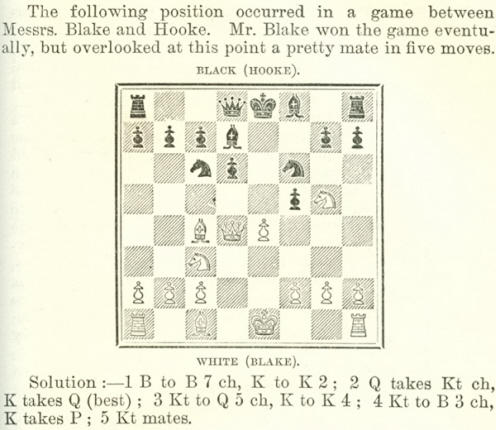
However, we add here that the game was played even earlier than 1889. It was published on pages 286-287 of the Chess Player’s Chronicle, 17 October 1888, taken from G.A. MacDonnell’s column in the Illustrated Sporting and Dramatic News:
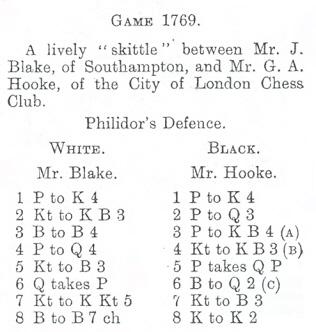
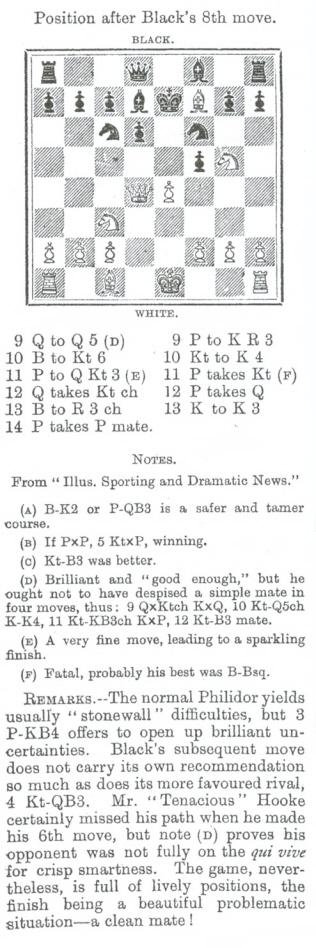
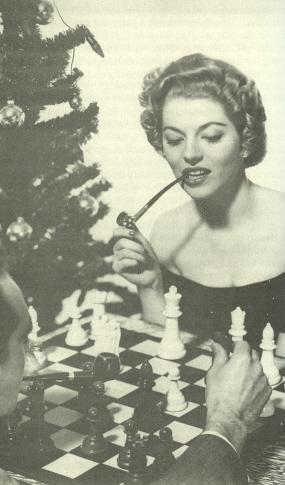
This is, we believe, a 1950s promotional photograph for women’s pipe-smoking, but are any more details available? It was published on, for instance, page 182 of The Ultimate Pipe Book by Richard Carleton Hacker (Beverly Hills, 1984).
W.D. Rubinstein (Aberystwyth, Wales) notes that I. Chernev discussed the two games between E.Z. Adams and C. Torre in a letter to the Editor (K. Whyld) on page 30 of the Summer 1957 Chess Reader:
‘Adams-Torre, New Orleans, 1920
Regarding this game, your American correspondent [an anonymous person referred to on page 28 of the Autumn 1956 issue] mentioned “the Adams-Torre (or vice versa) game”.
Let me clear up this affair.
There is one of each. You will find the famous one (Adams-Torre) together with the less well-known, but interesting Torre-Adams in the British Chess Magazine for 1926 on pages 249 and 250.
If there is any doubt as to Torre’s losing brilliantly by the successive queen offers, we have the notes of Torre himself in the November 1925 issue of the American Chess Bulletin. The game is also given in Les Cahiers de l’Echiquier Français in their first volume (1925) on page 52, with Torre’s comment that the best game he ever played was the one he lost to Adams.’
On the following page Whyld responded:
‘Regarding the Adams-Torre game, Chernev is quite right. Even so, the famous game is still often given the wrong way round, and the Revista Mexicana de Ajedrez gave it as Torre-Adams in its 1933 volume. Does anyone know the event in which these games were played? Incidentally, the Torre-Adams game appeared again in the BCM in 1942, under a heading “Mr Reinfeld is sending us some bright old games from time to time which have not hitherto appeared in the BCM”.’
We make two points:
1) When Torre v Adams (French Defence) and Adams v Torre (Philidor’s Defence) were published on pages 249-250 of the May 1926 BCM they had the heading ‘Two games played at New Orelans in 1920. Notes by J.H.B. [Joseph Henry Blake]’ Only the latter game had been published in the American Chess Bulletin (November 1925, page 157), and Blake’s source for the French Defence game is currently unknown to us.
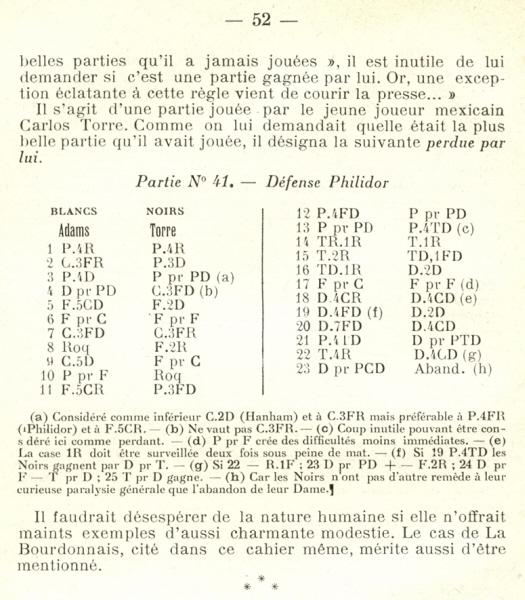
2) Chernev’s reference to Les Cahiers de l’Echiquier Français in connection with the Adams v Torre brilliancy is of interest. The French magazine (see the illustration above) did not mention Torre’s notes or give any date, merely indicating that the game had recently been appearing in print. Moreover, since the game was in the second cahier, whereas even the fourth one was still dated 1925, the French magazine apparently gave the game well before it appeared in the November 1925 American Chess Bulletin. But where did it obtain the game and, in particular, what was its source for the statement that Torre considered that loss his most beautiful game?
As stated on page 39 of Kings, Commoners and Knaves, the position below was given on page 108 of Creative Chess by Amatzia Avni (1991 and 1997 editions) with the heading ‘Dr O. Bernstein-Amateur, Stockholm, 1906’:
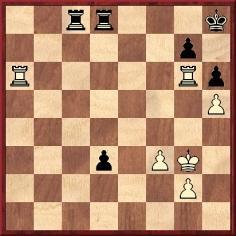
In this seemingly hopeless situation White was said to have drawn with 1 Rgd6 (If 1 Ra7 d2 2 Rgxg7 Rg8 and Black wins.) 1...d2 2 Rac6 Rb8 3 Rb6 Ra8 4 Ra6, but we pointed out that when the position appeared on page 1610 of L’Echiquier of 9 April 1932 it was given as a study, published in ‘Chakmatnoe Obozzenic 1906’ (i.e. Shakmatnoe Obozrenie).
Now René Olthof (’s-Hertogenbosch, the Netherlands) mentions, on the basis of information from Harold van der Heijden, that it was a composition published on page 148 of the 4/5 1906 issue of the Swedish magazine Tidskrift för Schack, being one of three studies by Bernstein dedicated to Ludvig Collijn, Hugo W. Langborg and Fritz Englund. The same information has been supplied by Calle Erlandsson (Lund, Sweden), who gives the page in question:
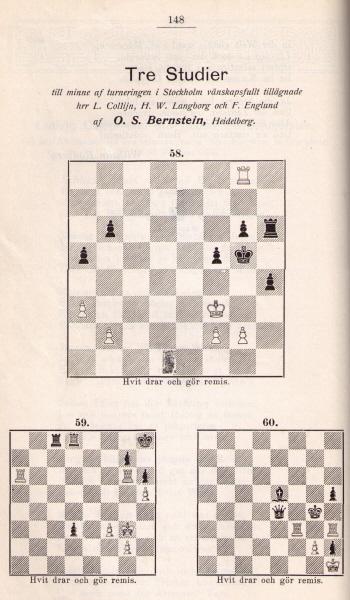
Mr Erlandsson also sends this group photograph taken during the Stockholm, 1906 tournament, from that year’s Tidskrift för Schack (between page 56 of issue 3 and page 57 of issue 4/5):
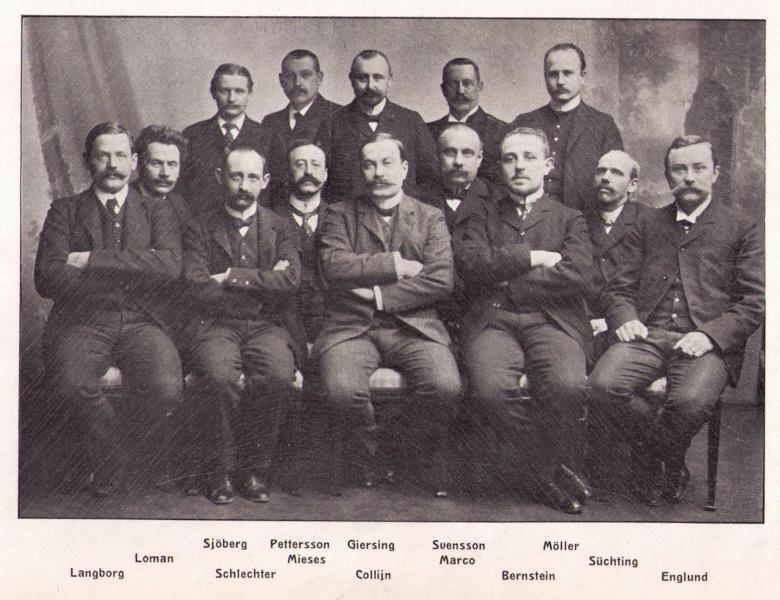
Information is still being sought about L. Nardus’ works of art and his bona fides or otherwise. We have a catalogue of an auction held in Paris on 9 February 1953; the paintings belonged to an unnamed person, some of them coming from Nardus’ collection (‘appartenant à Monsieur X ... et provenant pour partie de la Collection L. Nardus’).
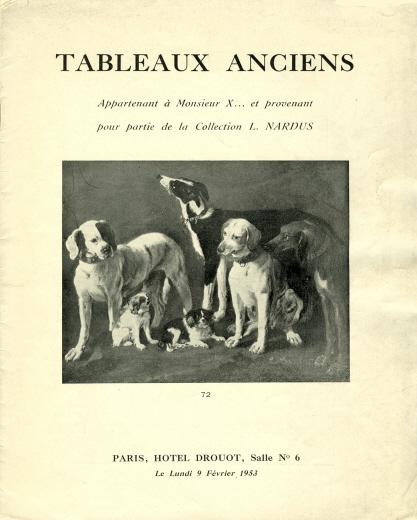
C.N. 5204 noted that page 409 of David Lawson’s book on Morphy referred to a poem by Sheriff W.C. Spens in the September 1875 Huddersfield College Magazine. However, Eric Fisher (Hull, England) informs us that the poem (whose first line was ‘Problems you term the poetry of chess’) was published in the June 1875 issue, page 185. It did not mention Morphy by name, but the last two lines are an ostensible reference to him:
‘Or that Chess Byron, who, with Europe’s bays,
Recrossed the Atlantic, then withdrew from gaze?’
At the moment, therefore, we have two poems by Spens specifically about Morphy:
One-stanza poem, the first line being:
‘By the bright winter fire I lightly read’.
Five-stanza poem, the first lines of the respective stanzas being:
‘He came to Europe: English sages smiled’
‘He played a glorious game: in open field’
‘About him was a gentle modesty’
‘He came, he saw, he conquered; then he went’
‘So o’er his clouded mind the sad years sped’.
As mentioned in C.N. 5204, the latter issue of the Herald had an endnote by Spens:
‘... There is something at once very sad and striking about Morphy’s career. The four first sonnets, which we subjoin (slightly altered) – written about ten years ago at the time of a report as to Morphy’s insanity – appeared in the Chess Player’s Chronicle, and have since been published in different chess publications. The fifth sonnet is substantially rewritten, but some of the lines appeared in a sonnet which was written at the time there was a report as to Morphy’s death in the autumn of 1882. W.C.S.’
From Christian Sánchez (Rosario, Argentina):
‘Has someone else played the “spurious” game 1 e4 e5 2 Nf3 d6 3 Bc4 f5 4 d4 Nf6 5 Nc3 exd4 6 Qxd4 Bd7 7 Ng5 Nc6 8 Bf7+ Ke7 9 Qxf6+ Kxf6 10 Nd5+ Ke5 11 Nf3+ Kxe4 12 Nc3 mate?
Roberto Grau gives the same game-score but without names on page 80 of volume I of Tratado general de ajedrez (Buenos Aires, 1939), and the position after 7...Nc6 with the heading “M. Seguin-X” on page 122 of the same volume. The solution is on page 221.
Kurt Richter gives the game on page 140 of Hohe Schule der Schach Taktik (Berlin, 1956) with the heading “Seguin-N.N., 1938”.’
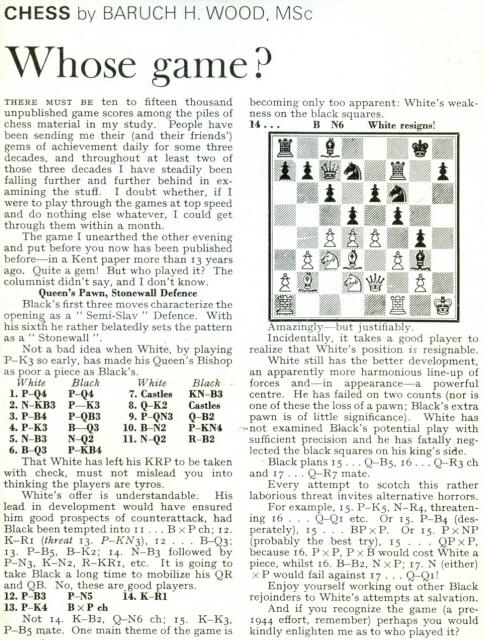
A precise source is currently unavailable for this cutting, but it would seem to come from the Illustrated London News around 1957. Quite apart from the identity of the players, we are not at all sure what to make of the game itself (1 d4 d5 2 Nf3 e6 3 c4 c6 4 e3 Bd6 5 Nc3 Nd7 6 Bd3 f5 7 O-O Ngf6 8 Qe2 O-O 9 b3 Qc7 10 Bb2 g5 11 Nd2 Rf7 12 f3 g4 13 e4 Bxh2+ 14 Kh1 Bg3 15 White resigns) or of B.H. Wood’s notes.
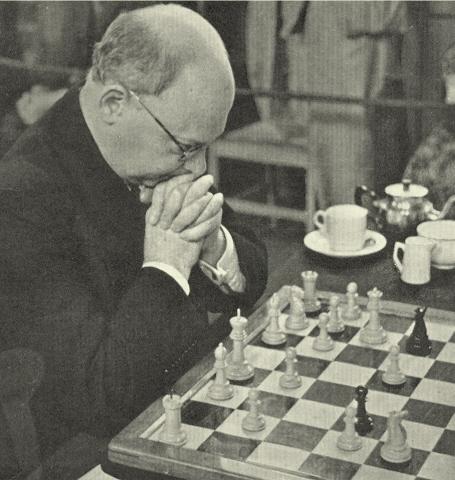
Savielly Tartakower
From Leonard Barden (London):
‘Tartakower played me in his Free French uniform and, a decade later, we met in the Cercle Caïssa in Montmartre.
The first occasion was in early 1945 when I visited Julius du Mont’s house and found the doctor there discussing 500 Master Games of Chess. I was already helping du Mont with checking proofs for the BCM and his columns and books, so he gave me some work while they finished their talk and then persuaded Tartakower to play me. He was the first world-class grandmaster I ever met, an imposing figure in the uniform. There were no clocks. He was Black in a Dutch Defence. He sortied his queen to a5, then blocked its retreat, allowing me to trap it in elementary fashion by b4. He resigned promptly, and suggested a second game. I had been reading My System so tried the Nimzowitsch Sicilian with an early d5, but was swiftly outplayed. I did not take a game-score.
In July 1955 I visited Paris, was told of the Caïssa café so went to the Boulevard Montmartre hoping to play for stakes and help finance my trip. There were around a dozen to 20 patrons each afternoon, presided over by a charming elderly lady, Madame Le Bey Taillis. My hopes of unsuspecting victims were soon dashed as Madame found out that I was British champion and introduced me gushingly as such to prospective opponents. So most days I ended up playing five-minute games with the café professional Sherbakov, who competed in one or two minor international tournaments of the time. We were evenly matched, and after several hours there were only a few centimes in it.
Tartakower used to visit daily and play almost exclusively with an old gentleman to whom he gave odds (I forget whether a knight or substantial time-odds). The amateur was accommodating, lost virtually every game, and paid up after two or three hours. One afternoon the doctor was late and the old gentleman was en prise, so I took the opportunity to become his opponent and to collect from him. After an hour or so Tartakower arrived and looked aghast at what was probably his rent and roulette money being usurped. He sat down on the same side of the table as the amateur and fixed me with a cold stare. I soon took the hint and gave way.
We left the café together later that evening and it seemed that Tartakower had not fully forgiven me. He was too polite to reproach me directly, but began a gentle probe. My French was poor, but he rarely uttered English words. “You have been an undergraduate. What did you study?” “History, doctor.” “Ah good, can you help me with a historical question?” “I’ll try.” “In what year was the Battle of Hastings?” “1066.” “Bravo, felicitations!” It was well-known that the doctor liked to use this last phrase sarcastically to people he thought had overstepped the mark. We said our farewells, I left for London the next day, and seven months later wrote a sympathetic obituary for the Guardian.’
Tony French (Worthing, England) asks for biographical information about E. Znosko-Borovsky (1884-1954) beyond what appears in the standard reference works.
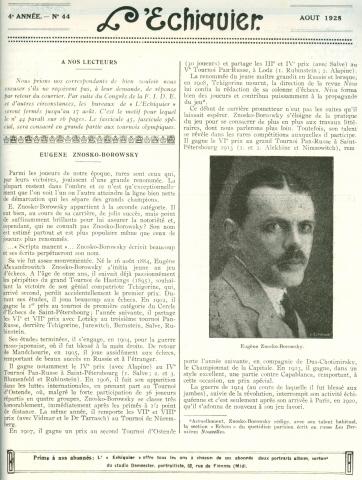 To
make a start, we mention an article about him by V. Soultanbéieff
on pages 987-988 of the August 1928 issue of L’Echiquier.
This stated that he began chess at an early age and followed
Hastings, 1895 closely in the hope that his compatriot Chigorin
would win. After completing his studies, in 1904 he engaged in the
Russo-Japanese War, where he injured his right hand. He returned
to Manchuria in 1905. In the Great War he suffered damage to his
legs, and he did not resume chess until arriving in Paris in 1920.
To
make a start, we mention an article about him by V. Soultanbéieff
on pages 987-988 of the August 1928 issue of L’Echiquier.
This stated that he began chess at an early age and followed
Hastings, 1895 closely in the hope that his compatriot Chigorin
would win. After completing his studies, in 1904 he engaged in the
Russo-Japanese War, where he injured his right hand. He returned
to Manchuria in 1905. In the Great War he suffered damage to his
legs, and he did not resume chess until arriving in Paris in 1920.
Znosko-Borovsky was described as a man of letters and of the theatre who brought out a significant work in Russian: a treatise on Russian theatre in the early twentieth century. He also wrote a number of plays, the first of which was banned. (‘Znosko-Borowsky écrivit aussi plusieurs pièces de théâtre, dont la première, Le croiseur “Almase” (Tsou-shima), un drame, fut interdit par la censure.’) It was also stated that he was briefly (in 1918-1919) a theatre director.
R.H.S. Stevenson had written along similar lines on pages 172-173 of the May 1921 BCM. Additional information included the following:
‘Volunteering for service in the Russo-Japanese War, he was wounded at the battles of Mukden and Liao-yang, receiving a Commission and the Cross of St George.’
‘In the Great War he fought in the Russian drives which culminated in the capture of Prshmesyl [sic] and Lemburg, being seriously wounded and sent back to Petrograd. After the Revolution he lived in the mountains of Caucasia and ran a very successful theatre there for nine months. He is now in Paris editing Russian newspapers ...’
Philip W. Sergeant contributed a biographical introduction on pages vii-xi of Znosko-Borovsky’s The Art of Chess Combination (London, 1936), but offered few additional specifics. Following Znosko-Borovsky’s death, Gerald Abrahams wrote on page 102 of the March 1955 BCM:
‘His reputation as a dramatic and literary critic was, at one time, considerable in Europe, though England knew little of this.’
We hope to build up more information about, in particular, Znosko-Borovsky’s non-chess activities. Have readers seen any of his writings on subjects other than chess?
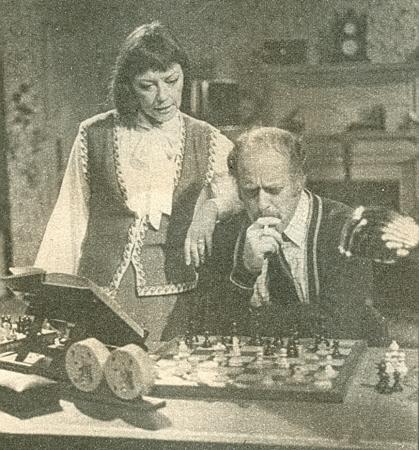
Readers in the United Kingdom will have an advantage in identifying the persons in this photograph.
Schönheit der Kombination by Werner Golz and Paul Keres (East Berlin, 1972) featured the writings of Kurt Richter, and there are also two editions of the English version, Combination as a Fine Art (London, 1976 and Ramsbury, 1989). Richter made extensive use of the fictional ‘Dr Zabel’, but what is known about the origins of the character?
We note that page 68 of Richter’s book Der Weg zum Matt (Berlin, 1941) included the following:
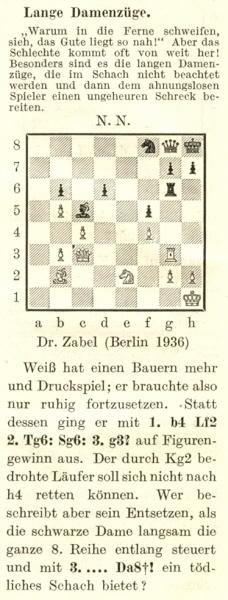
Fabio Molin (Rome) submits two photographs which he took at the Keres Museum in Tallinn at the end of September 2007:
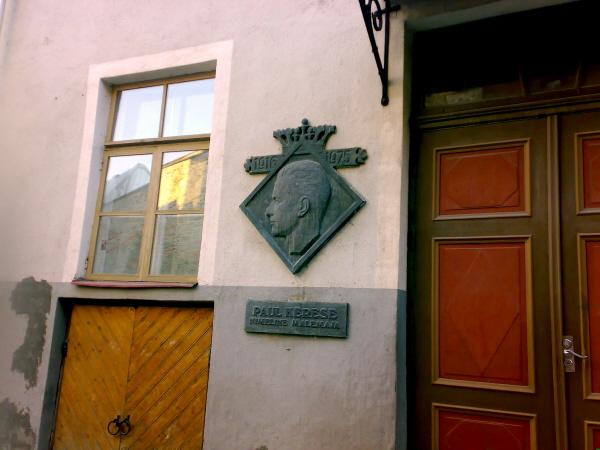
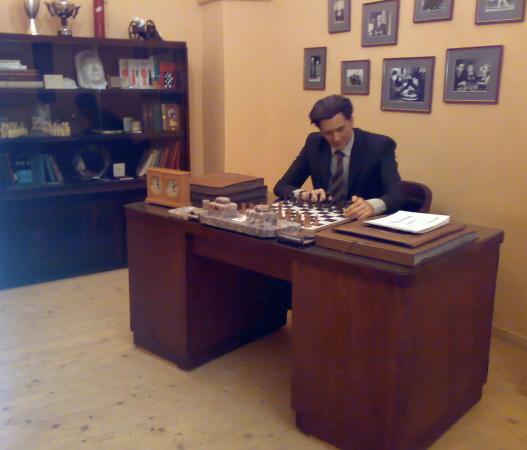
The celebrated miniature Schuster v Carl Carls was discussed in several C.N. items in the early 1980s (see pages 178-179 of Chess Explorations), and here we provide an overview of what is known, and unknown, about the game.
The moves are not in doubt: 1 e4 c6 2 d4 d5 3 Nc3 dxe4 4 Nxe4 Nf6 5 Ng3 h5 6 Bg5 h4 7 Bxf6 hxg3 8 Be5
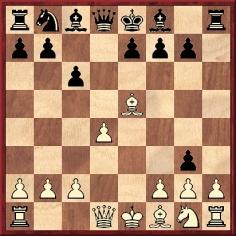
8...Rxh2 9 Rxh2 Qa5+ 10 c3 Qxe5+ 11 dxe5 gxh2 12 White resigns.
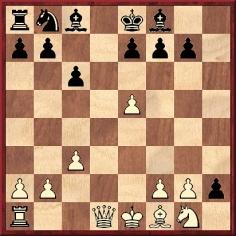
C.N. 293 indicated that the game was played in a tournament in Oldenburg, 1914, and not 1913 as stated, for instance, in the source quoted in C.N. 237 (page 297 of The Year-Book of Chess 1914 by M.W. Stevens). The occasion is, though, often given as ‘Bremen, 1914’ (e.g. by Pal Benko on page 156 of Chess Life & Review, March 1973 and by Nikolay Minev on page 30 of Inside Chess, 8 March 1993). The moves appeared on pages 167-168 of Deutsches Wochenschach, 10 May 1914. A brief account and the crosstable of the weekend tournament (referred to as ‘der 3. Kongreß des Oldenburgisch-Ostfriesischen Verbandes’ and held on 7-8 March 1914) were supplied on pages 94-95 of the 15 March 1914 issue of the German magazine.

In C.N. 778 we pointed out that on pages 183-184 of 200 Miniature Games of Chess (London, 1941) J. du Mont gave Schuster v Carls (‘Bremen, 1914’) and wrote:
‘Curiously enough, the identical game was played in an off-hand encounter won by Torre in Mexico 15 years later.’
As noted on page 268 of Chess Explorations, the following
appeared on page 327 of the August 1929 BCM:

Concerning the concluding moves, in C.N. 417 W.H. Cozens wrote in connection with Schuster v Carls:
‘This famous old combination ... is unsound. White has only to play 10 Qd2! (instead of 10 c3) and the combination is bust, for after 10...Qxe5+ 11 dxe5 gxh2 12 O-O-O Nd7 13 Nh3 h1(Q) 14 e6 fxe6 15 Be2 Qxg2 16 Bh5+ Kd8 17 Nf4 White wins quickly. 12...Bd7 also loses. Black would have to play (after 10 Qd2) ... Qxd2+ 11 Kxd2 gxh2 12 Bxh2 Bf5 with equality. This was pointed out by G. Porreca in L’Italia Scacchistica in 1953.’
However, in a subsequent item (C.N. 619) we reported:
‘The September 1983 issue of Schacknytt has two pages of pickings from C.N., and the writer, Sixten Johansson, gives a further twist to the Schuster-Carls combination, which was declared unsound in C.N. 417 on account of 10 Qd2. The simple yet curiously unobvious point is that White loses his queen after 10...gxf2+. We learn that E. Böök published the “refutation” of Carls’ combination in his chess column that appeared in a Finnish railwaymen’s magazine, having taken the refutation from Shakhmaty v SSSR in 1964. Some weeks later a correspondent from Lieksa pointed out 10 Qd2 gxf2+, previously overlooked by everybody. Böök mentions that Kurt Richter in Deutsche Schachblätter, 1936 and H.J. van Donk in Schakend Nederland, 1966, also wrongly claimed that the Carls brilliancy was “bust”.’
The game was given (as N.N. v Torre, Mexico, 1928) on page 175 of the July 1964 Chess Life, and a reader of Larry Evans’ column, Vincent Mooney, reverted to it on page 40 of Chess Life & Review, January 1970:
‘Several years ago grandmaster Rossolimo showed me that White should play 10 Q-Q2, and then QxBch 11 PxQ PxR 12 O-O-O! B-Q2 13 P-K6 PxP 14 N-B3 P-R8(Q) 15 B-B4 QxP 16 N-N5!! and it seems White has a won game. Does Black have a better defense: e.g., 15...QxRch – I have tried about six lines and in all of them White seems to have a win, even though he is a bishop and pawn down at the end of move 15, unless 15...QxRch is played?’
Evans replied:
‘Black wins rather easily after 10 Q-Q2 PxPch! followed by 11...QxQch and 12...PxN(Q).’
Is it known where the game was ascribed to Torre before publication in the BCM? As regards Carls’ victory, there seems no reason to doubt the above-mentioned statement in Deutsches Wochenschach that the occasion was a tournament in Oldenburg in 1914. On the other hand, Carls also defeated Schuster in the 1913 tournament held there (for the crosstable, see page 242 of the German magazine, 6 July 1913). Schuster, though not Carls, participated in the first Oldenburg tournament too (whose crosstable appeared on page 242 of the 7 July 1912 issue). In none of these, or other, contemporary references have we yet found the forename of Schuster, who, according to page 129 of the 6 April 1913 Deutsches Wochenschach, was from Wilhelmshaven.
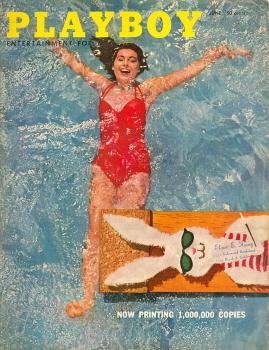
The June 1956 issue of Playboy had a section entitled ‘Chess – a compendium’:

Al Horowitz’s ‘A Short, Happy History of Chess’ contained such material as the following (page 51):
‘One would hardly suppose that there could be so much connection between chess and sex, and yet both legend and historic record show some extraordinary twists and turns in this respect. There is an amusing yarn, for example, about the siege of Troy, according to which the Greek chieftains whiled away the time in a chess tournament. Briseis, a tasty female slave, was to be the prize. Achilles and Agamemnon became the finalists, and Achilles lost both the tournament and the girl when his crafty rival plied him with wine. Small wonder that the mighty warrior afterward sulked in his tent.’
The short story ‘Last Gambit’ by Loring D. Mandel was well written and well tailored to the Playboy readership’s predilections. The centrefold ‘playmate of the month’ was 18-year-old Gloria Walker, a telephone operator ‘born and bred in the Bronx’:
‘Gloria strikes a rather classic pose as our June pin-up, wearing naught but a towel whilst engrossed in a game of chess. Gloria doesn’t ordinarily play chess in such brief attire. We don’t know whether Gloria ordinarily plays in such brief attire, but we know she doesn’t ordinarily play chess in such brief [sic], because she doesn’t ordinarily play chess.’
C.N. 996 (see page 120 of Chess Explorations) referred to a secret game between Reshevsky and Muffang played at Easter 1920, and we quoted CHESS, April 1945, page 113:
‘Reshevsky’s manager stipulated that the result of the game should not be made public unless Reshevsky won!! This 25-year-old undertaking has only now been broken.’
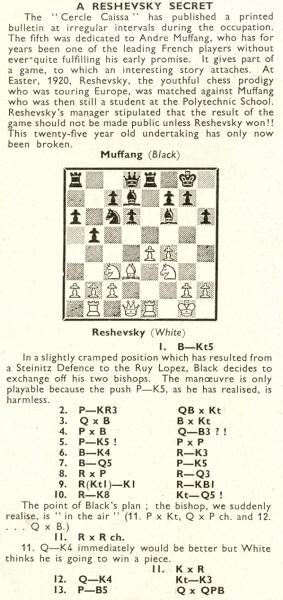
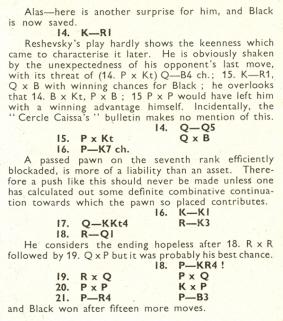
Dominique Thimognier (St Cyr sur Loire, France) provides the original text in issue 5 of Caïssa (1944):
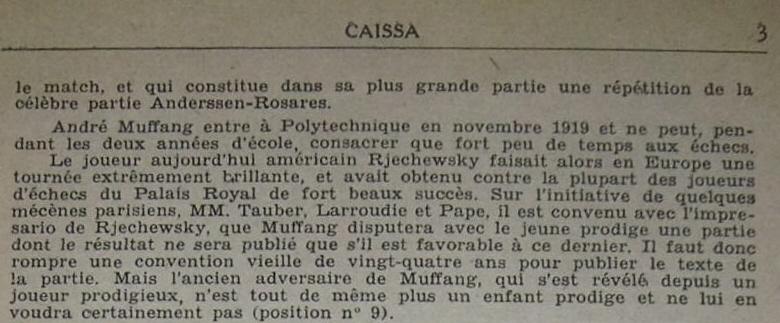
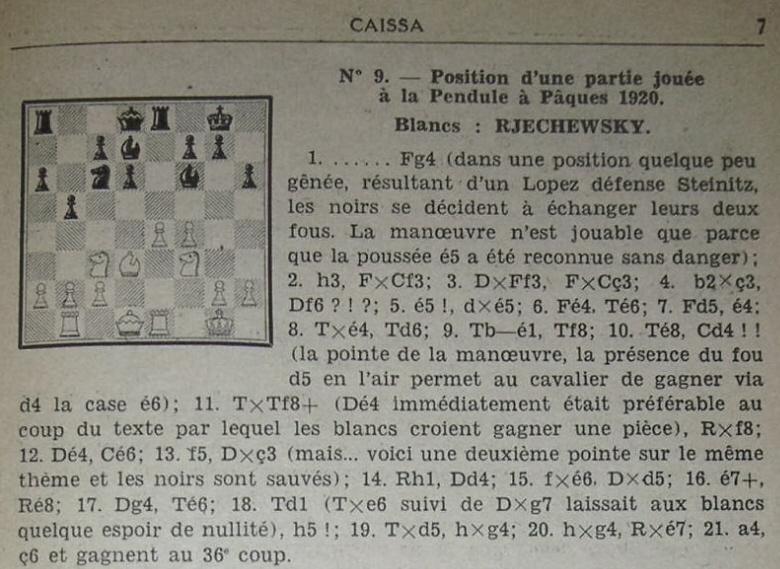
Mr Thimognier also draws attention to a website on French chess history which he is developing, Héritage des échecs français.
As mentioned on page 422 of Deutsches Wochenschach, 12 November 1911, at Capablanca’s simultaneous display in Mannheim on 29 October 1911 (+31 –1 =3) one of the draws was secured by Dr Erckenbrecht of Hockenheim. Hans-Georg Kleinhenz (Munich, Germany) has now found the game-score on page 8 of Akademisches Monatsheft für Schach, X. Reihe, Heft 7, February 1912:
José Raúl Capablanca – Erckenbrecht1 e4 e5 2 Nf3 Nf6 3 Nxe5 d6 4 Nf3 Nxe4 5 d4 d5 6 Bd3 Bf5 7 O-O Nc6 8 Re1 Be7 9 c4 O-O 10 cxd5 Qxd5 11 Bxe4 Bxe4 12 Nc3 Bxf3 13 Nxd5 Bxd1 14 Nxe7+ Nxe7 15 Rxe7 Rfe8 16 Bg5 Rxe7 17 Bxe7 Re8 18 Bb4 Ba4 19 b3 Bd7 20 Rc1 c6 21 Kf1 Bf5 22 Rc3 Rd8 23 Bc5 b6 24 Ba3 Rxd4 25 Rxc6 Rd2 26 Bc1 Rxa2 27 h3 h6 28 b4 Bd3+ 29 Kg1 b5 30 Be3 a5 31 bxa5 Rxa5 32 Rb6 Ra2 33 Rb7 Rb2 34 Bc5 Rc2 Drawn.
The photograph below comes from Kh. R. Kapablanka Opyt kharakteristiki by E.A. Znosko-Borovsky (St Petersburg, 1911):
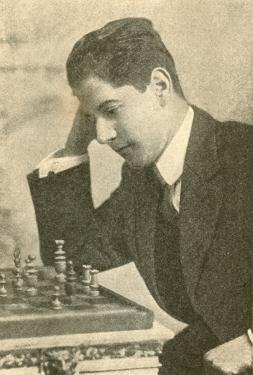
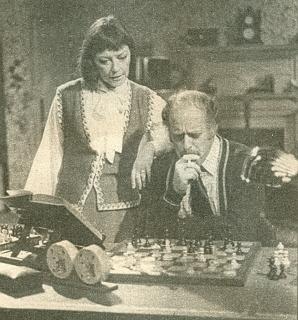
This photograph features Dorothy Tutin and Clive Swift in Willow Cabins, a play written by Alan Plater, directed by David Cunliffe, produced by Yorkshire Television and broadcast on 1 December 1975. We culled the picture from page 11 of TV Times, 29 November-5 December 1975, where it accompanied an article, ‘Chessbored’, by Paul Jennings.
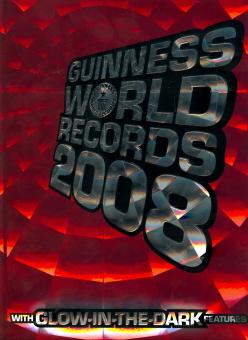
Our annual report on the chess content of the book Guinness World Records is, for the 2008 edition, of record brevity: there is no chess content.
Page 197 of The Guinness Book of Chess Grandmasters by William Hartston (Enfield, 1996) quoted a familiar old quip:
‘By the time FIDE organized the world championship tournament in 1948, Fine had begun to shift his attentions from chess to a career in psychoanalysis. He declined an invitation to the 1948 event because it clashed with his final exams. His decision was later described by one wit as “a great loss for chess and at best a draw for psychoanalysis”.’
Who first made that remark, and where?
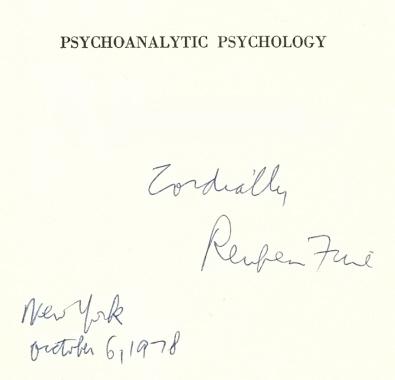
From Harry Woolverton’s column in the Ilford Recorder, 16 February 1978 we take a loss by Tigran Petrosian in a simultaneous display:
Tigran Petrosian – Trevor Carr1 d4 Nf6 2 Nf3 e6 3 Bg5 d5 4 Nbd2 Nbd7 5 e3 b6 6 Ne5 Nxe5 7 dxe5 h6 8 Bh4 g5 9 exf6 gxh4 10 Bb5+ Bd7 11 Bxd7+ Qxd7 12 Qh5 Qa4 13 b3 Qa5 14 a4 Qc3 15 Rd1 Qxf6 16 O-O Rg8 17 Kh1 Bd6 18 Nf3 O-O-O 19 Qxh4
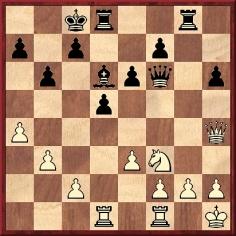
19...Rg5 20 e4 Rdg8 21 exd5 Qg6 22 Nxg5 hxg5 23 Qg4 f5 24 Qe2 e5 25 g3 Rh8 26 f3 Qh7 27 Qg2
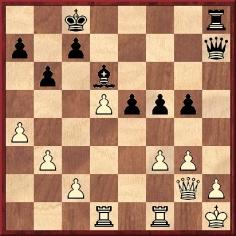
27...e4 28 fxe4 f4 29 gxf4 gxf4 30 Rd3 Rg8 31 Qe2 Qg7 32 Rdf3 Bc5 33 h3 Qd4 34 Kh2 Rg1 35 c3 Qg7 36 b4 Qg3+ 37 White resigns.
Woolverton remarked:
‘The winner, who is 17, has been somewhat overshadowed by his brilliant young brother, Neil, but he is a fine player in his own right.’
The newspaper’s chess column of 9 February 1978 gave another loss by the former world champion (to A.L. Burnett), as well as this account of the display:
‘Before commencing Mr Petrosian stated that he did not wish to play longer than three hours, at 48 he tires more rapidly, and shortly before he had received a pounding from some stiff opposition at the YMCA, where after 5½ hours he lost nine and drew 11 games out of 30.
But at Ilford against a more modest challenge his speed was remarkable; in the first hour he had made 23 circuits of the arena. Of all those who have played at Ilford he was the fastest, and this includes many of the greatest names the game has known. The quality of the play suggests that he is now a little over the hill for such exhibitions, but even so it was an impressive tour de force.’
Petrosian lost three games and drew five, but the total number of boards was not specified.
Matthew O’Hara (Arvada, CO, USA) draws attention to a webpage regarding The Pride and the Sorrow (‘a novel about Paul Morphy’).
The author, Matt Fullerty (Washington, DC, USA), informs us that he hopes to have his book published in the summer of 2008.
Etienne Cornil (Braine-l’Alleud, Belgium) reports that he has made available at the website of the Cercle Royal des Echecs de Bruxelles a 268-page treatise on the Café de la Régence. The illustrations include, on page 121, a photograph of Paul Journoud (1821-82) that was new to us.
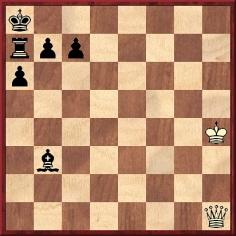
White to move and win
This position was given on page 201 of Chess Combination as a Fine Art (see C.N. 5229) with the caption ‘From a Belgian chess column – No source given’. Is the identity of the composer known?
From Alan McGowan (Waterloo, Canada):
‘Richter took over the Hauptschriftleitung (chief editorship) of Deutsche Schachblätter with the 1 January 1934 issue. On pages 28-30 of the second number (15 January 1934), he introduced Dr Zabel, in an article entitled:
“Dr. Zabel will Schachmeister werden
Unsystematische Streifzüge durch Theorie und Praxis”.
Richter continued to use the character in his instructional (and entertaining) articles in the magazine up to 1939. Sometimes Dr Zabel would be featured in analysis of a complete game, and sometimes as part of a survey of middle-game or combinational aspects. The magazine ceased publication in 1943 but re-appeared from 1948 to 1952. During that latter run Richter occasionally used Dr Zabel in articles.’
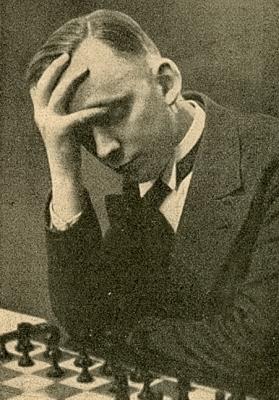
Kurt Richter, Deutsche Schachblätter, 1 May 1936, page 131
Thomas Binder (Berlin) comments:
‘The word “Schachzabel” is the medieval term for the game of chess, Schachzabelspiel, as well as for the chess board (originating from the Latin tabula, meaning a table or board).’
A group photograph from page 173 of Deutsche Schachblätter, 1 June 1936:
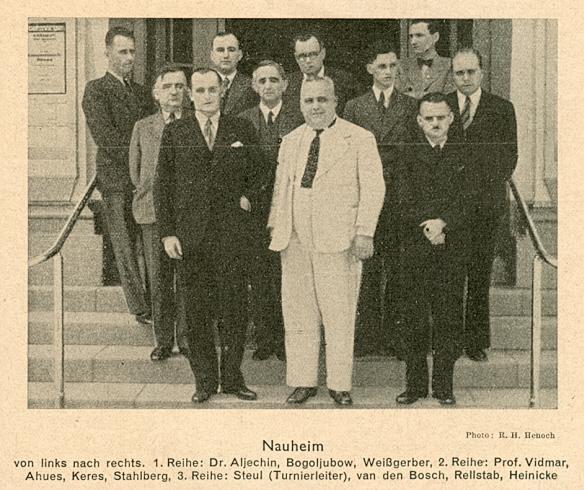

From Michael McDowell (Westcliff-on-sea, England):
‘The position is a mate in five by Walther F. von Holzhausen, published in Rigaer Tageblatt in 1912. I found it in Brian Stephenson’s online Meson database.
We see that the composition was reproduced on page 77 of Deutsches Wochenschach, 3 March 1912, with the solution (1 Kg5 Bg8 2 Qf3 Bf7 3 Qh3, etc.) given on page 204 of the 9 June 1912 issue.
Page 235 of Deutsches Wochenschach, 30 June 1912 mentioned a person from Fellin (i.e. Viljandi) named F. Reinfeld.
Jan Kalendovský (Brno, Czech Republic) submits two caricatures, of Tarrasch and Tartakower, from Schach Karikaturen aus der internationalen Schachwelt by E. Gőndőr (Vienna, 1922):
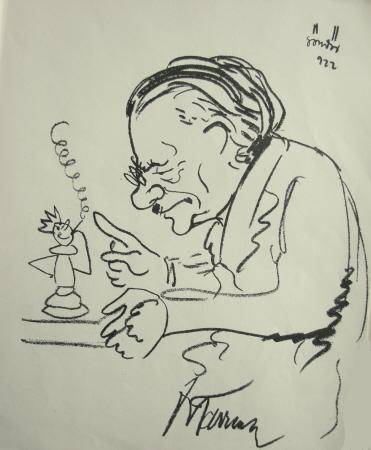
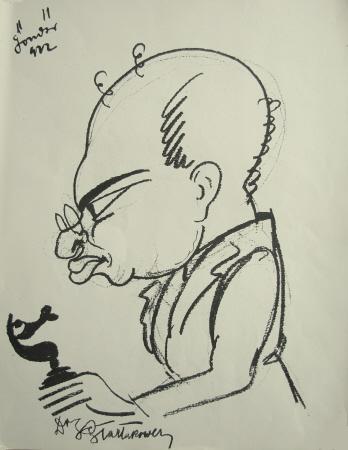
Documented examples of Georg Marco’s wit are still being sought. In particular, we should like an exact source for a remark commonly attributed to him:
‘Black’s position is perfectly balanced. It is weak on the king side and equally so on the queen side.’
The above wording is taken from page 52 of The Chess Scene by David Levy and Stewart Reuben (London, 1974), which merely stated ‘Marco, on a tournament game’.
C.N. 1792 cited from page 3 of the Winter 1988 issue of Chess Post a neat message for use in correspondence chess:
‘If resigns, thank you for the game.’
In C.N. 2426 the late David Pritchard referred to a postcard on which a player wrote his latest move and added:
‘If Rd7, resigns.’
On the broader topic of correspondence chess, we have before us a passage by C.H.O’D. Alexander from his Sunday Times column on page 82 of the Supplement, 8 April 1973:
‘Punch-drunk at the moment from struggling with my games in the World Team Final I am incapable of annotating anyone else’s games; here, therefore, is one of my own [against Ulyanov] from a Cheltenham v Sochi friendly match. Friendly – yes I suppose so; but not conducted in any spirit of levity or undue haste. One of our team went round the world by sea in the middle and only got two moves behind the rest of us; and while I won this game in the comparatively short time of 2½ years, in my other game against Ulyanov I have been on the defensive for four years – I hope to equalize any year now.’
From John Nunn (Chertsey, England):
‘I recently received a pre-publication copy of White King and Red Queen by Daniel Johnson. In it I read (page 11) that “Rubinstein’s sanity, always precarious, gradually left him and he spent his last 30 years in a sanatorium”. A similar claim was made in another recent book, The Immortal Game by David Shenk, which stated (page 143) that “... [Rubinstein] spent the last 30 years of his life in a mental institution”. I was surprised both by these claims and the similarity between them (the precise 30-year figure).
I may be mistaken, but I had the impression that while Rubinstein may have suffered bouts of mental illness, he had regular contact with other players in the post-War years. Do you know of any evidence that might support the claims of Johnson and Shenk or is this just a myth?’
We propose to deal with the matter in some detail. Firstly, it will be recalled that Akiba Rubinstein’s serious chess career ended in the early 1930s, at which time his personal circumstances became desperate. The text below appeared on page 111 of the March 1933 BCM:
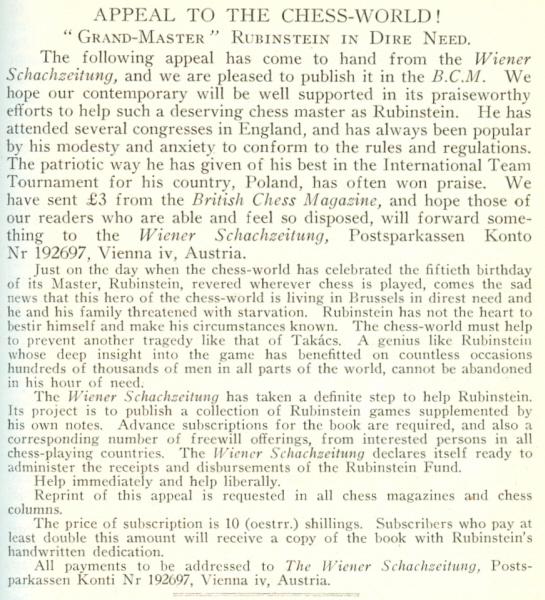
Here is Rubinstein’s inscription in one of our copies of the book subsequently published, Rubinstein Gewinnt! by Hans Kmoch (Vienna, 1933):
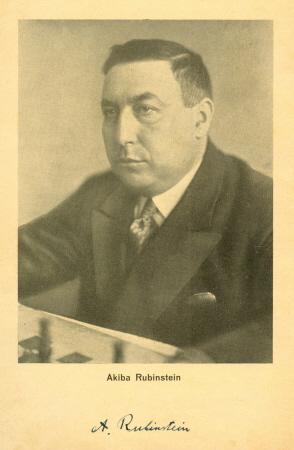
The remainder of his life, nearly three decades, was so tragic and obscure that chess writers have had a field day light-mindedly filling in the gaps. From page 148 of Impact of Genius by R.E. Fauber (Seattle, 1992):
‘The rest of the story is sadder. He had settled in Belgium and, after 1932, talked to no-one but his immediate family. When his wife died, conversation grew even more sparse. He stopped bathing and let his hair and beard grow without shaving or clipping. The Nazis came in 1940 and asked this wild-haired Jew if he was willing to work for the Third Reich. He said yes, and this frightened them. Even an SS ape was still able to feel awe and fear in the presence of a man divinely or hellishly mad. For 30 years he lived in a silent and unwashed purgatory until his death in 1961.’
No sources were provided for any of that, of course, but it seems that Fauber was decorating an article about Rubinstein by Hans Kmoch on pages 176-177 of the June 1961 Chess Review. After relating his failure to secure Rubinstein’s participation at Bled, 1931, Kmoch wrote:
‘Nor was this writer more successful five years later when he made the trip from Amsterdam to Brussels in order to invite Rubinstein to a tournament in Holland. This last meeting with the grandmaster (as it proved to be) was but brief. For Mrs Rubinstein warned beforehand: if a visitor doesn’t leave soon, Rubinstein himself might leave, possibly through the window.
Another World War broke out, and Rubinstein, although now living at the other end of Europe, came again under German occupation, this time a much more dangerous one. But, miraculously, he survived, even without any extra effort. When they came to fetch him and asked whether he was willing to work for Germany, he simply said yes, and that seems to have frightened them. At any rate, they withdrew and left him alone for the rest of the War. It happened in Belgium, after all, where the Germans, as in Denmark, showed some restraint in return for the King’s capitulation.
A few years ago, Mrs Rubinstein passed away; and, with her, Rubinstein died his second death. He would no longer wash, shave, have his hair cut, change his clothes nor speak a word. He stayed on only as a living corpse, until recently the corpse also demised.’
Kmoch, whose account indicated that his last personal meeting with Rubinstein was in 1936, did not specify the provenance of the details concerning the remainder of Rubinstein’s life.
As regards the story about Rubinstein being invited ‘to work for Germany’, we wonder whether the article in the 1961 Chess Review was its first appearance in print. Subsequently, M. Najdorf related it with particular relish. For example, C.N. 1660 referred to his statements on page 25 of the June 1988 Revista Internacional de Ajedrez, in an interview with Eduardo Scala:

In short, after asserting that he was an exception in being allowed into the Rubinsteins’ home Najdorf said that after the Nazis invaded Poland Rubinstein expressed delight when invited to work in a concentration camp. The Gestapo thus concluded that Rubinstein was truly insane, and the master avoided going to a death camp. The fact that Rubinstein was in Belgium, not Poland, during the Second World War, apparently passed Najdorf by.
A similar account by him was quoted on page 109 of Najdorf x Najdorf by Liliana Najdorf (Buenos Aires, 1999):
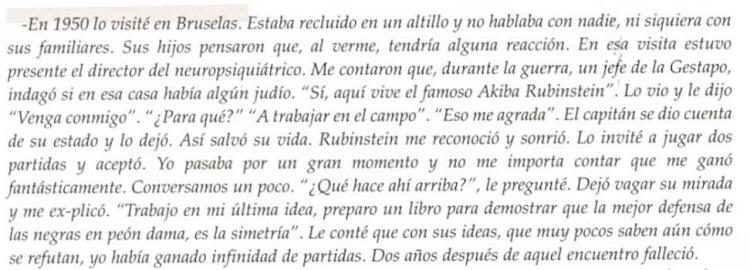
Here, M. Najdorf affirmed that in Brussels in 1950 he visited Rubinstein, who had shut himself away in an attic and spoke to nobody. Also present during the visit were Rubinstein’s sons and the director of a neuropsychiatric institute, and they told Najdorf the Gestapo story. Najdorf added that Rubinstein agreed to play two games with him and that Rubinstein won in fantastic style. Najdorf then asked him what he did in his attic, and received the following reply: ‘I am working on my latest idea; I am preparing a book to demonstrate that the best defence for Black in the Queen’s Pawn Opening is symmetry.’
Najdorf’s narrative ended by stating that two years after this meeting Rubinstein died. Since the visit purportedly took place in 1950 and Rubinstein’s death, in Antwerp, occurred on 15 March 1961, that is just one more example of the kind of discrepancy without which no reportage by Najdorf is complete. On the other hand, the comment on symmetry for Black is a reminder of a reference to Rubinstein on page 122 of the April 1940 BCM:
‘He is living in retirement in Brussels but is still actively concerned with chess analysis, notably with an exploration of the variation 1 P-Q4 P-Q4 2 P-QB4 P-QB4.’
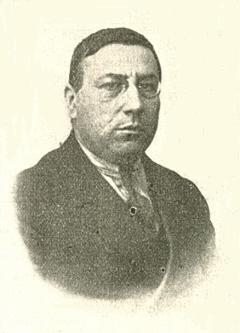
Akiba Rubinstein
Whether Max Euwe, any more than Hans Kmoch, had first-hand knowledge of, or contact with, Rubinstein after the 1930s is not clear to us, but he too related the Nazi story, in an interview with Hans Bouwmeester. Below is the English version (complete with the anecdotalist’s ‘once’) which appeared on page 200 of CHESS, September 1981:
‘He finished his life in a mental asylum in Antwerp. During the war these asylums were sometimes exploited as refuges by resistance workers. Nazi investigators once descended on the place and asked Rubinstein, “Are you happy here?” “Not at all”, Rubinstein replied. “Would you prefer to go to Germany and work for the Wehrmacht?” “I’d be delighted to”, Rubinstein replied. “Then he really must be barmy”, the Nazis decided.’
In passing we also cite a vague claim on page 176 of Max Euwe by Alexander Münninghoff (Alkmaar, 2001):
‘Until long after the war he [Rubinstein] languished in lamentable circumstances in a Belgian institution, and it wasn’t until 1961 that he finally gave up the spirit, which in another sense had long since departed.’
Specific information about the Rubinstein family’s circumstances after the Second World War was provided in a letter from Kaethe Aschkenes on page 1 of Chess Review, March 1948:
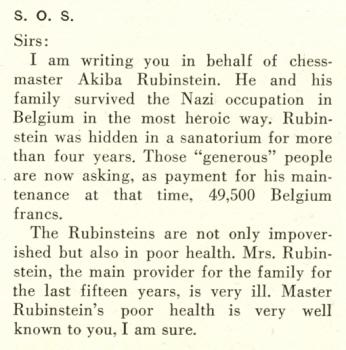
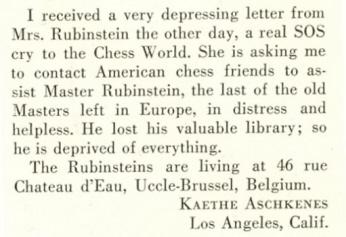
The master’s younger son, Sammy Rubinstein, supplied some details for C.N. in 1985 (see pages 121-122 of Chess Explorations). He was questioned by a correspondent of ours, Karl De Smet (Brussels), who submitted a recording of their exchanges (in French), from which we made a summary. Among the facts provided were the following:
Akiba Rubinstein married in 1917, and his wife (née Lew) bore him two sons, in 1918 (Jonas) and 1927 (Sammy). She died in 1954. The master played in private at home with Yanofsky, Najdorf and O’Kelly. (Pages 119-122 of D.A. Yanofsky’s book Chess the Hard Way! (London, 1953) gave a game he played against Rubinstein at the latter’s home in Brussels in February 1947.)
Our summary of Sammy Rubinstein’s reminiscences concluded:
‘The family lived together (A.K.R.’s wife having opened a restaurant in the early 1930s) until 1942. S.R. spent 1943-44 in the hands of the Germans. After the death of his mother, S.R. suffered a depression and spent three-four years in a psychiatric institute.
At home A.K.R. tended to remain alone in his room, being very uncommunicative. Sammy concludes: “Chess was everything for him, and I don’t believe it is enough to fill a life. You have to do other things as well.”’
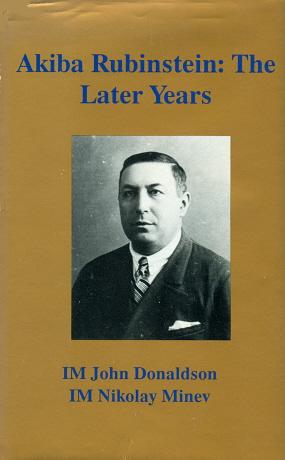
The most detailed examination of Rubinstein’s long final period is in Akiba Rubinstein: The Later Years by J. Donaldson and N. Minev (Seattle, 1995). See, in particular, pages 1-8 and 290-291, which included the following information:
The above biographical information was obtained by John Donaldson during a visit to Jonas Rubinstein and his wife in Charleroi, Belgium in 1995 (as noted on page 290).
On page 3 of their book Donaldson and Minev wrote (prior to demolishing a Koltanowski yarn):
‘Most stories concerning Rubinstein are at best half truths, which have become so embellished over time that they bear little resemblance to what actually transpired.’
That is indisputable. Much about the last 30 years of Rubinstein’s life is unclear or unknown, but it is evident that for most of that period he lived at home, and not in a sanatorium or mental institution.
With regard to the player named Blum whom G. Koltanowski attacked for financial impropriety, Dominique Thimognier (St Cyr sur Loire, France) notes on page 422 of the October 1933 BCM a reference, in connection with the French championship, to ‘Dr Oscar Blum (who has been spending some time in London since the Folkestone Congress)’. Our correspondent also mentions that page 6 of the December 1932 issue of the Bulletin de La Fédération Française des Echecs (which had the results of that year’s Paris championship) stated that Blum was Lithuanian. In Folkestone he participated not in the Olympiad but in the ‘General Congress’, finishing second, half a point behind Znosko-Borovsky.
A challenge to readers: how many players in this photograph can be identified?
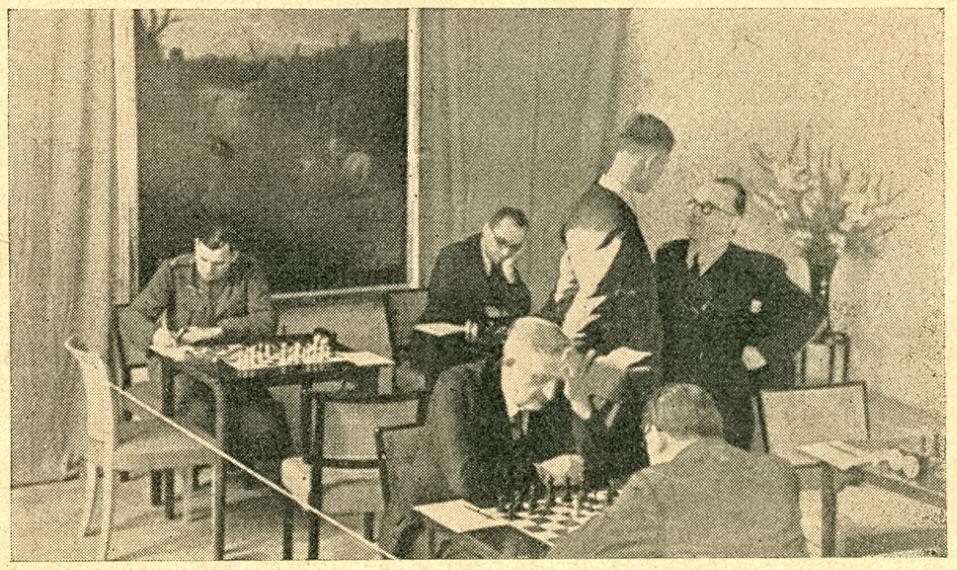
A number of C.N. items have discussed chess and war (see the entry for ‘Warfare’ in the Factfinder), and here we add that another article on the subject appeared on pages 6-7 of the January 1916 BCM: a report on a lecture ‘Analogies between Chess and War’ delivered by Herbert Jacobs at the Hampstead Chess Club on 23 October 1915. However, it all seems rather facile, and we are still looking for an in-depth treatment of the subject.
In our occasional discussion of chess and poetry, no mention has previously been made of James Pierce (1833-92). He brought out two anthologies of poems, Stanzas and Sonnets (London, 1887) and In Cloud and Sunshine (London, 1890). He was relatively prolific and, for example, the former volume concluded (pages 181-198) with a substantial section of poems on chess which had appeared in the BCM.
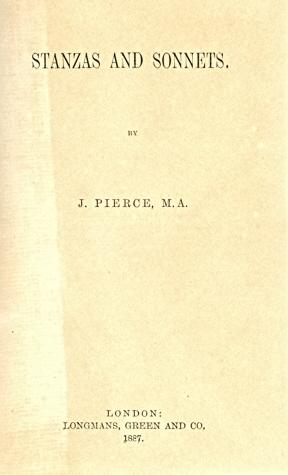
| First column | << previous | Archives [39] | next >> | Current column |
Copyright 2007 Edward Winter. All rights reserved.